
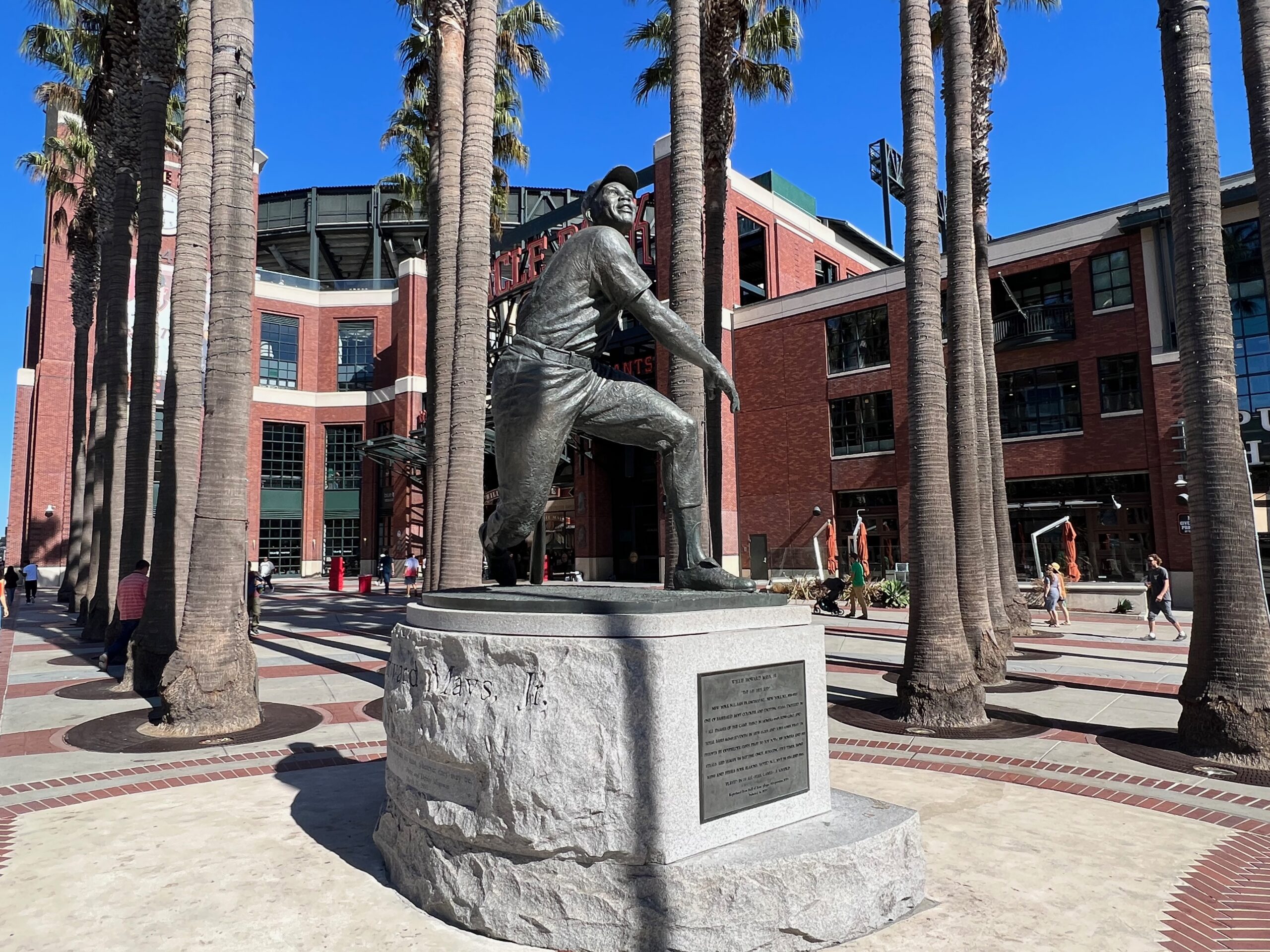



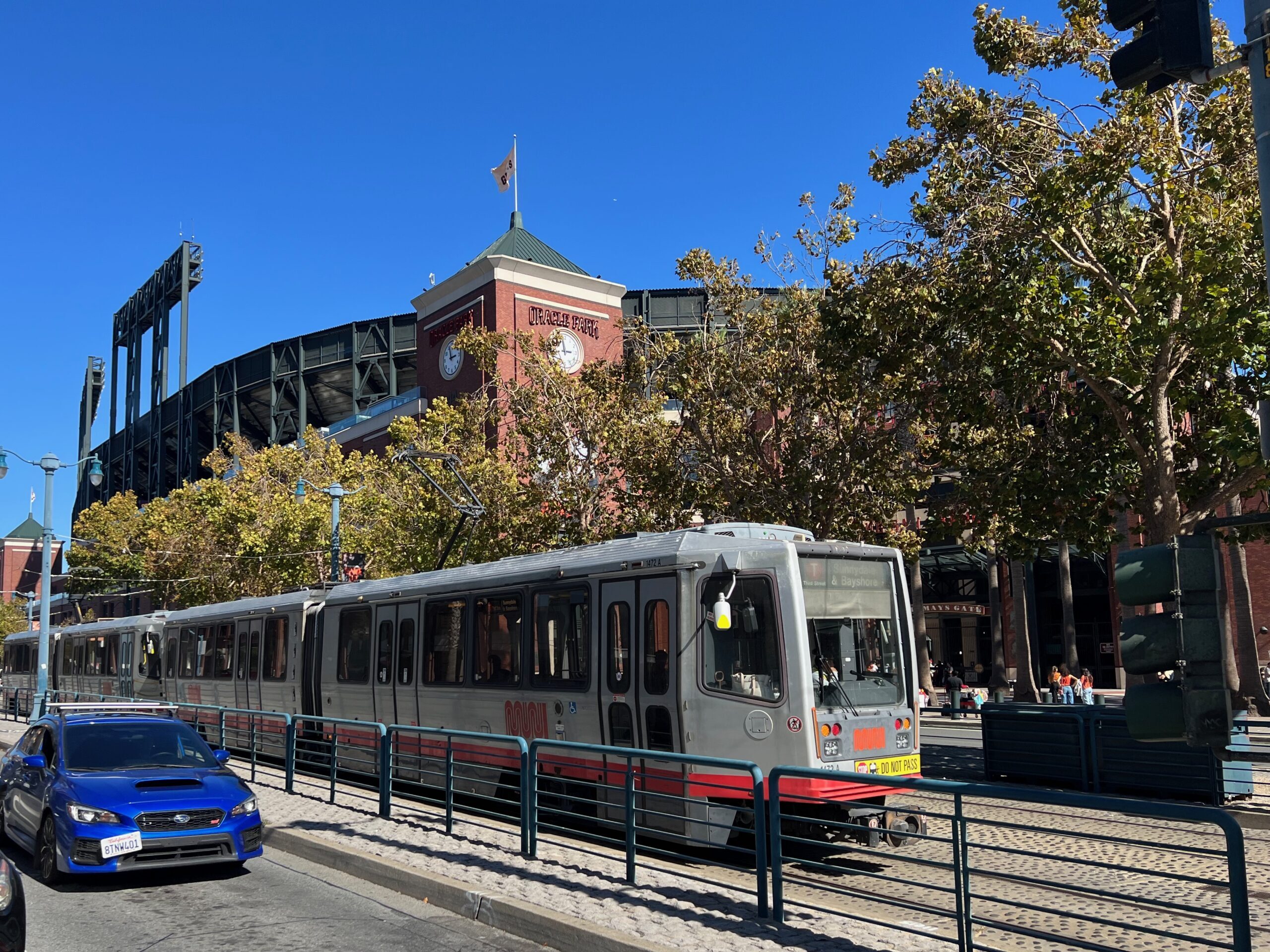

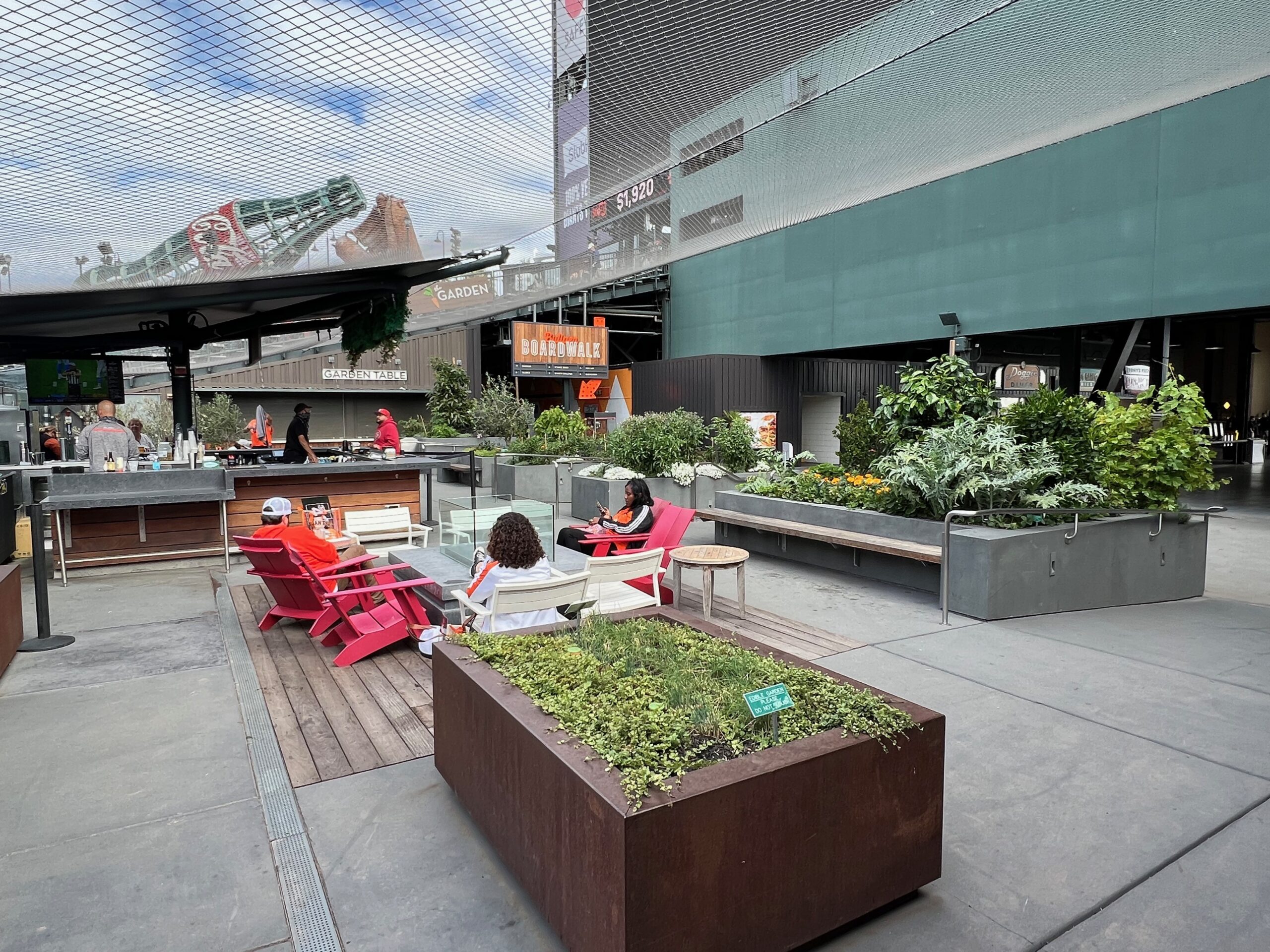
Oracle Park
| Setting | 18.5/20 | 1 Thumb Up |
|---|---|---|
| Locale | 5/5 | 2 Thumbs Up Star |
| Accessibility | 4.5/5 | 1 Thumb Up |
| Neighborhood Local Scene | 9/10 | 1 Thumb Up |
| Architecture & Aesthetics | 56.5/65 | 2 Thumbs Up |
|---|---|---|
| Exterior Design/Aesthetics | 14.5/20 | 1 Thumb Up |
| Interior Aesthetics/Visuals | 38.5/40 | 2 Thumbs Up |
| Concourse Aesthetics | 3.5/5 | Thumb Sideways |
| Functionality & Essentials | 31.5/50 | 1 Thumb Down |
|---|---|---|
| Sightlines: Field Proximity | 10.5/15 | Thumb Sideways |
| Sightlines: Seating Geometry | 2/5 | 1 Thumb Down |
| Seat Comfort | 6/9 | Thumb Sideways |
| Concourse Functionality | 7/15 | 1 Thumb Down |
| Scoreboards/Tech | 6/6 | 2 Thumbs Up |
| Amenities & Features | 43.5/50 | 2 Thumbs Up |
|---|---|---|
| Concessions: Food Variety | 5/5 | 1 Thumb Up |
| Concessions: Food Quality | 5/5 | 1 Thumb Up |
| Concessions: Craft Beer/Other Drinks | 5/5 | 2 Thumbs Up |
| Social Gathering Areas/Restaurants | 7/10 | Thumb Sideways |
| Premium Seating/Clubs | 8/9 | 1 Thumb Up |
| Historical Exhibits, Memorabilia, Art, & Other Displays | 8.5/10 | 1 Thumb Up |
| Kids Areas/Other Entertainment | 5/6 | 1 Thumb Up |
| Atmosphere, Vibe, & Policies | 13/15 | 1 Thumb Up |
|---|---|---|
| Fan Support/Attendance | 5/5 | 2 Thumbs Up |
| Ballpark Traditions/Gameday Presentation | 5/5 | 1 Thumb Up |
| Ballpark Policies/Staff | 3/5 | Thumb Sideways |
| Adjusted Raw Score | 162/200=81 |
|---|---|
| Bonus | 4 |
| Curve for All 7 | 7 |
| Final Score | 92.5 |
|---|---|
| Ranking | #3/30 |
|---|---|
More Than a Ballpark by the Bay
Despite tiny footprint, logistical issues, Oracle Park’s immaculate vibes, attention to detail, superb concessions, fantastic location, and of course, postcard views make it one of the best in the game
By: Cole Shoemaker
Originally published in 2011, ratings above are up to date for 2023, but this review below may be outdated and will be updated at some point during the 2023 season; reviews and ratings are “living pages” updated yearly when necessary
First impressions and high expectations are what characterized my first trek to Oracle Park. Scores of critics have gushed over the blending of a world famous city known for its postcard views with a perfect ballpark. As well as Oracle Park represents San Francisco, it’s a bit of a paradox for me.
Brilliantly shoehorned between King Street and China Basin just southeast of SoMa in urban San Francisco, Oracle Park’s greatest achievement is its appreciation of the site. In an era where ballparks gained their identities through synthetic quirkiness and the self-conscious whims of the PR department, Mays Field is legitimately derived through adaptation to its environment. All of the design virtues are born of necessity.
Regarded by many as the pinnacle of the neoclassical ballpark renaissance, I was first struck by how thoroughly the architecture is integrated with the urban form. By orienting the park toward the San Francisco Bay, the red brick facade behind home plate and on the third base side is one with the warehouse buildings along King Street.
Ballparks that are oriented toward the city skyline are often left with home plate entrances surrounded by parking lots. San Francisco has the best of both worlds: postcard bay views in the outfield and contextual architecture around the infield. Oracle’s approach echos that of a Wrigley Field or Fenway Park: it’s so seamlessly integrated with the surrounding fabric, you don’t realize you’re even approaching the park until you get there.
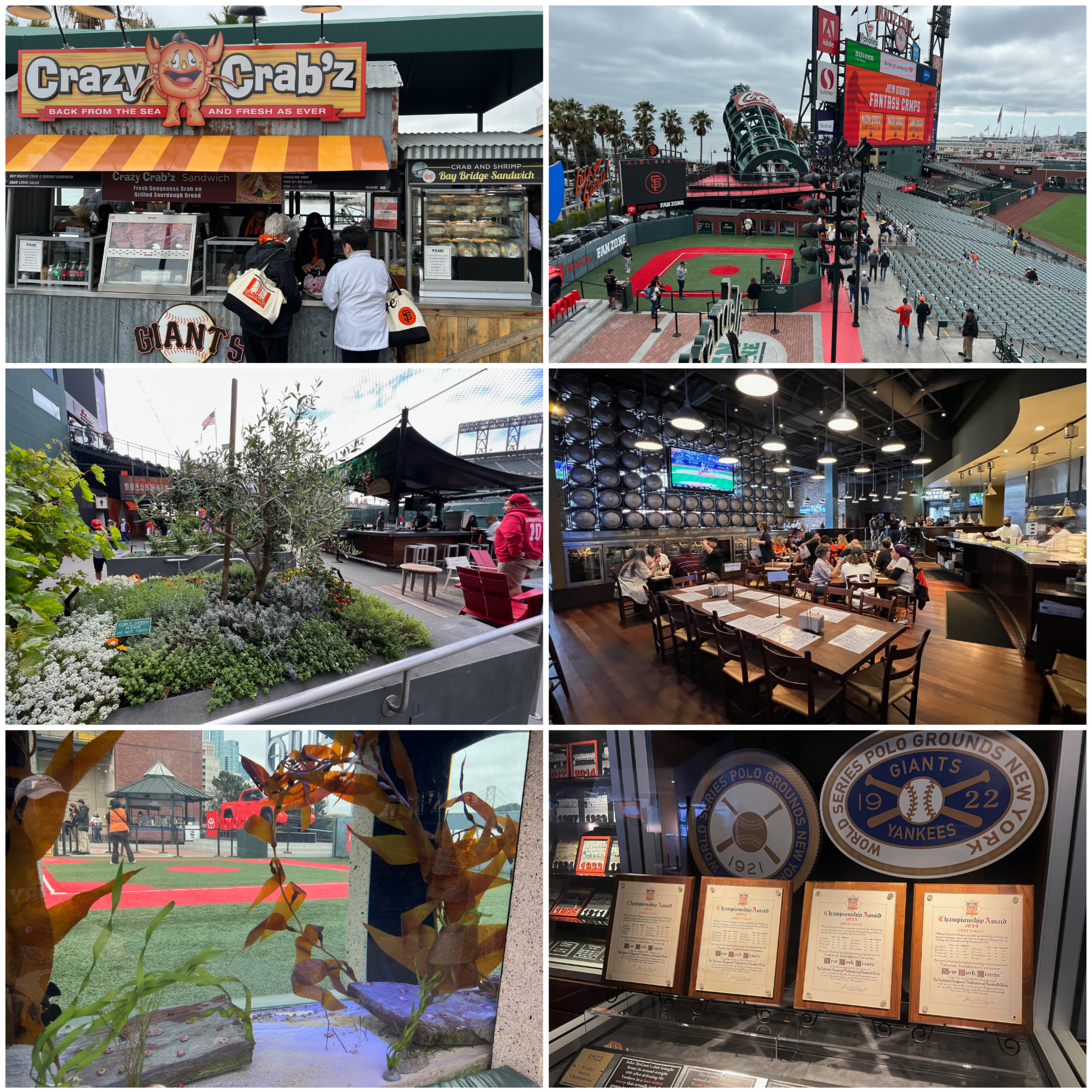
Once I was inside, I was overwhelmed by the extent of the amenities and attention to detail. Just take the food. It’s taken a step back in recent years, but historically, the quality and selection of the grub are so expansive they transcend the generic categories of BBQ, Asian, Mexican, Seafood, etc, and are instead subdivided into specialties characteristic of Caribbean BBQ, Irish, Italian, authentic Mexican, Thai, Chinese, etc. Plus, Oracle Park has one of baseball’s very best craft beer selections.
Historical touches are everywhere you look despite the spatial constraints, from the statues and “wall of fame” on the outside, to the thoughtful quotes and murals throughout the concourses on the inside. Every single available space, even throughout the ugly ramps, is appointed with a historical quote.
The array of seating options and premium experiences are incredibly well-thought out, from the “Triples Alley” concept where fans can be on the warning track during batting practice, to the “Alaskan Airlines Loft” integrated into the arches, invoking a bay front home. In 2014, the Giants added arguably the most exclusive private membership club in baseball. Cleverly dubbed the Gotham Club, members get a flurry of perks, including access to a swank bar and dining area behind the right field out-of-town scoreboard, exclusive field access, and a private game room on the suite level.
Instead of being the usual burden to the average fan, the innovative kid-related activities are taken to a whole new level, instead integrated into the aesthetic appeal of the ballpark. The left field coke bottle, meant to add a small amount of whimsy to a monotonous array of bleachers, is both functional and attractive, containing slides for kids leading to a mini baseball field.
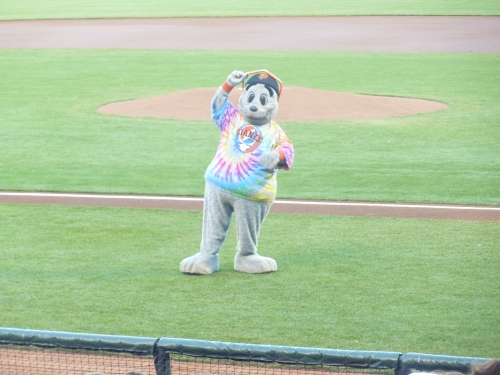
I took all of this in while walking the concourses, and concluded this was as nice as a ballpark could be. Then I reached the final part of my walk around, the sensational Arcade in right field, and was quickly reminded that Oracle Park is best known for sitting on the gorgeous San Francisco waterfront.
I mean this both as a huge complement and a modest critique.
While Oracle Park boasts the most scenic views in baseball from the upper levels, there’s little mention of the city or the water visually from the lower bowl. Unlike at parks in Pittsburgh or Detroit, you don’t have a view of the cityscape or the water if you’re sitting in a lower level seat. It’s not until you get to the very top of the mezzanine that you begin to see that cyan hue, and the bay is only fully visible from the nosebleeds.
It also doesn’t quite capture or take advantage of all elements in the environment, such as the San Francisco skyline or the bay bridge. While the interior aesthetics are still one of the very best in baseball, I don’t quite have it on par with PNC Park in Pittsburgh in terms of contextual integration, where the beauty just seems omnipresent no matter where you’re sitting.
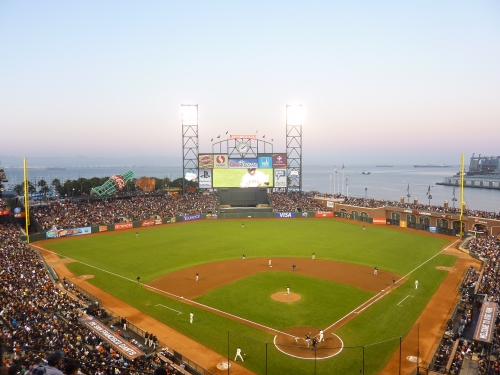
That being said, this realization demonstrates a second point: this is a great ballpark even without the view. Think unique social spaces like The Garden, choice food and craft beer, lots of historical artwork, plenty of fun for the kids, a vibrant atmosphere by virtue of 20 years of near sellouts, and just immaculate vibes created by the small things like baseball’s best music and baseball’s only female P.A. announcer.
While much of the media hype surrounds McCovey Cove – and yes, it’s well deserved; those are mere quibbles above – Oracle Park’s attention to detail and thoughtfulness regarding the little things is unappreciated and just as good.
However, Oracle Park is not flawless. Far from it, in fact. Oracle Park does the little things well, but it has a couple of big issues stemming from the tight footprint. While the constrained site makes Oracle Park incredibly charming in some respects, it also means that park isn’t always the most functional. The biggest problem is the narrowness of the concourses.
The main concourse is 25-28 feet in width, far below the modern standard. Short concession lines constantly impede circulation. Bottlenecks are common, particularly in the left and right field corners transitioning to the outfield concourse, where the left field concourse feels like a narrow passageway and the right field arcade only measures about 10 feet. Field visibility from the main concourse is also poor due to kiosks, earthquake-resistant columns, and a low ceiling, even though the Giants have tried to improve this since Oracle Park opened. This is one of the most difficult ballparks to walk around inside.
In addition, Oracle Park’s seating geometry is generally poor down the left field line on all three levels, with the seats not aggressively oriented enough toward home plate, or in some cases, oriented behind home plate from the outfield. By 2022, I also felt that Oracle Park was beginning to show its age in some other respects. The concourse signage feels outdated, and some interior areas could use some TLC.
These logistical issues are boring, but they count on my scorecard. In fact, they count enough to prevent me from ever ranking Oracle Park #1 in baseball.
At the end of the day, Oracle Park meets expectations as one of baseball’s most beautiful ballparks by virtue of its captivating water views inside and charming urban sensibility outside, while exceeding expectations in terms of thoughtful design flairs and amenities, despite being limited by the extremely small footprint. I have it #3 in the triumvirate of all-time great 21st century ballparks that will withstand the test of time, along with PNC in Pittsburgh and Petco in San Diego.
Setting
Location/Access:
Offering more ways to get to the ballpark than ever seen before, AT&T Park is one of the most successful downtown retro ballpark regarding accessibility.

Somewhat like Minute Maid Park and Safeco Field, San Francisco’s ballpark wasn’t built at the center of downtown, but at an area on the outskirts of the central business district, which warranted revival. But unlike the former two, AT&T Park has been extremely successful in rejuvenating the area. When you couple the growth in the direct area with its literal location on the San Francisco Bay, and its vicinity in one of the greatest cities in the world, you have the best location in baseball.
AT&T Park is just south of the Bay Bridge on the corner of 3rd and King Street. The MUNI light-rail trains will bring you right up to the ballpark from many locations downtown. BART can get you from anywhere in the city to the Embarcadero Station. Don’t forget the ferries across the bay, either. I recommend staying somewhere downtown and walking to the ballpark if you want to explore the city.
Score: 5/5
Local Scene:
While built in a formerly mediocre area on the outskirts of the city, the renovated area south of Market Street has evolved into one of the best local scenes in baseball. Once abandoned warehouses are now waterfront bars and dining establishments. There was a huge boom in trendy high-rise condos around the area. In typical San Francisco fashion, there’s a Barnes & Noble and Starbucks just outside the ballpark.

Score: 5/5
Total: 10/10
Architecture & Aesthetics
Exterior Design:
Unlike the exquisite facade in Denver, AT&T Park’s exterior design lacks much of the expected striking qualities. Instead of echoing the eclectic cornucopia of famous historic and modern architecture of San Francisco, HOK choose to wrap an exciting ballpark in an urbane brick cloak, lacking many of the accents seen on other brick facades across the majors. While the setup is nice enough on the whole, it comes off as one of the safer exterior designs in baseball.

While not representing San Francisco, AT&T Park does deserve credit for emulating the industrial buildings of the South Beach neighborhood. The façade of brick panels and square glass windows mimic the area perfectly, despite being a generic looking building. Like Turner Field in Atlanta, the façade itself is rather plain and derivative, lacking much to distinguish it from a regular brick building. I guess orange brick is appropriate because it fits the Giants color.
However, one very nice subtle touch is the vertical array of black bricks in between the dual sets of windows, meant to represent the stitching on a baseball. Because the field is at street level (thus, not sunk in like other ballparks), the structure isn’t as intimate as others, especially since the upper deck seems to disproportionately tower over the structure below.
Decorated with palm trees, the Willie Mays Plaza behind home plate has become the iconic exterior image of AT&T Park. It is a great area for fan to congregate before the game. The trees are wrapped in orange lights at night. Don’t forget to check out the cream colored exterior façade in center and left field.
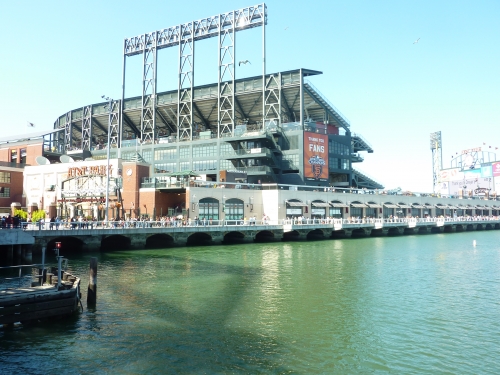
Score: 6.5/10
Interior Aesthetics:
While not equating the near perfect interior designs in Pittsburgh, Baltimore, or Cleveland, AT&T Park’s simple interior treatment is based around two design principles: complete adherence to site constraints and integration of the San Francisco Bay into the ballpark. By and large, the Giants hugely succeeded on both accounts, building a timeless structure with downscaled interior lines.
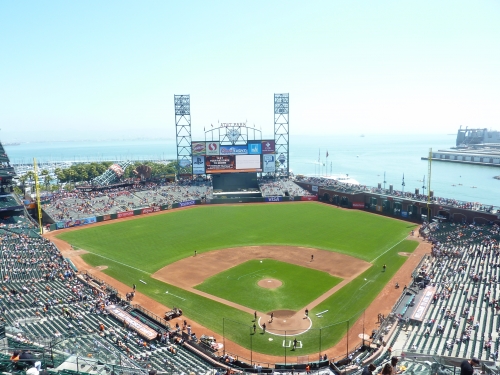
Unlike many of its retro peers, the nature of AT&T Park’s aesthetics is solely derived from its location, not contrived quirks or arbitrary asymmetry. If you look at the blueprints, you’ll note that the dimensions of the field align with the lines of China Basin to a tee. The short porch in right field is dictated by McCovey Cove, as is the deep right center field power alley. The wall runs parallel to the water. While “gimmicky” or “contrived quirks” don’t annoy me too much, as long as they’re aesthetically pleasing, I admit it is refreshing that these quirks are authentic.
Unlike almost every other retro ballpark, the outfield seating structure is rather monotonous and simple, especially the set up of bleachers in left field. AT&T Park is the only ballpark in the majors with no second deck seating in the outfield, in the interest of the bay view. Note the gentle slope of the left field bleachers that preserves the view of the palm trees.
Also unusual, the center field batter’s eye is plain and unadorned, stripped of the usual attractive frills. I see no aesthetic appeal in center field, where you usually see some sort of ivy or grass decoration. Honestly, I can’t blame them for this measure, as the visual focus should be solely on the nautical elements. However, this would be a great place for a “batter’s eye restaurant” (especially since this is the only ballpark built in recent memory without some kind of restaurant or table seating with a field view). Surely they’ve thought of this, so I assume that it’s not logistically possible.

AT&T Park is one of the few to integrate arches into the inside of the ballpark. The highlight from an aesthetic perspective, the gorgeous arched promenade is a subtle reference to the nearby Memorial Stadium in Berkeley, where fans can catch a peek at the game. It’s fitting that AT&T Park has brick on the inside to match the Giants’ primary color.
The sharp linearity of the arched promenade is nicely juxtaposed with the unadorned bleachers in left and center field. While a centerfield scoreboard location often implies a boring design, such as in Miller Park, Citi Field, Turner Field, it works particularly well here. Located in right field in the original renderings, its current location preserves the bay view with sailboats and palm trees in left field, while maintaining the integrity of the archways in right field. We have particularly good balance inside AT&T Park.

San Francisco’s method of displaying the bay views is particularly interesting, despite not being perfect. As previously discussed, you can’t see the bay from the lower bowl, but I’m not sure how the architects could have made this possible. But as spectacular as the views from the upper deck are, there’s a certain irony in the fact that AT&T Park doesn’t take advantage of it setting as well as it could.
Because of the site constraints, the right field upper deck is cut off very early in the infield. Contrary to popular belief, the views on the right side aren’t particularly good; ironically, the way the decking structure cuts off provides a great view of a parking lot, despite accentuating the porch and facilitating splash down home runs.
Even better views could have been possible down the left field lines, particularly showing part of the skyline and the Bay Bridge, if they had cut off the left field deck similar to the right field deck. Unfortunately, this was simply not feasible, because seating capacity would have been too low. While there’s little the architects could have done, AT&T Park doesn’t take advantage of all available landmarks. To their credit, the architects did a fantastic job of keeping the left field upper deck in foul territory, facilitating some bridge views for fans sitting in right field.
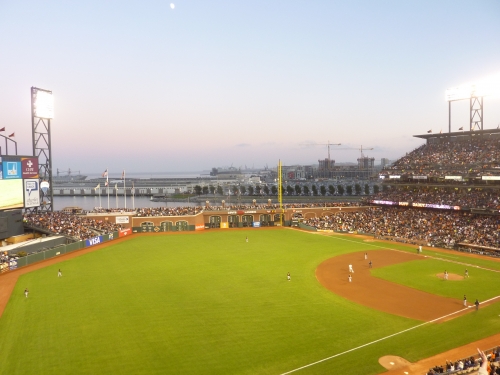
Of course, how can we not discuss the somewhat controversial coke bottle and giant vintage glove above left field? By the way, the coke bottle was originally necessary for sponsorship money to fund the ballpark. Personally, I think this structure needs a tiny bit of kitsch, in what is a monotonous array of seating.
That being said, the fact that you need a small gimmick tells me you’re not quite at the level of PNC, Camden, or Jacobs, which doesn’t need anything flashy. Similarly, Target Field is an example of a ballpark that also needed some whim, but chose not to have any.
Anyway, these elements add to the aesthetic appeal of the ballpark, meaning they’re acceptable gimmicks. The coke bottle also serves a functional purpose. The glove is an authentic baseball element that enhances the classic ethos of the ballpark. Both elements add a necessary amount of pomp and are well positioned to maintain the view of the bay bridge.
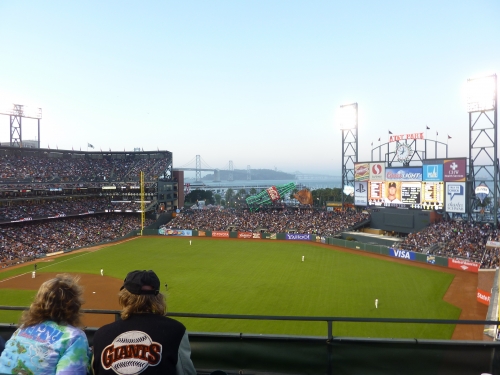
Perhaps the most overlooked part of any interior design deserves attention here: the field itself! Unlike almost every other park in the majors, the outfield grass is free from any annoying designs. They don’t have the usual checkerboard pattern mowed into the grass. It’s extremely clean and refreshing. The dirt consists of crushed volcanic rock different from what we’re use to, resulting in a lighter shade of brown. All of this supplements the already vintage ballpark feel.
Ultimately, while not quite as good as Jacobs, Camden, or PNC, AT&T Park’s simple contextual design deserves huge praise. And for those that commonly say, “It wouldn’t have been as cool if not for the bay view,” just remember AT&T Park is the way it is because of the bay view.
Score: 14/15
Panoramic View/Backdrop:
When discussing the view itself, not necessarily how well the ballpark showcases the view, you can’t beat the San Francisco Bay panorama. Even before the neoclassical ballpark craze, the possibility of a downtown view was certainly in the minds of architects and fans. But building a ballpark on the ocean is pretty transcendental (actually, before Candlestick was enclosed, it had a distant bay view).
But AT&T Park is more than just gorgeous sea blue water. It’s a perfect picture. On the left field side, note how the ballpark perfectly integrates the sailboats and palm trees. You have to go to the game to notice the Berkley Hills across the bay as well, which are in practice equal the Rocky Mountain Views at Coors Field. You couldn’t imagine a scene that better represents the bay area.
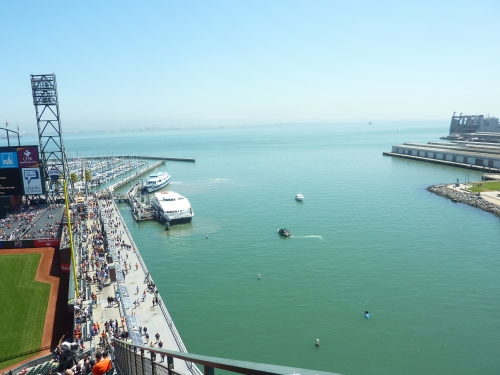
Score: 5/5
Concourses:
In an unintentional nod to Candlestick Park, the narrow concourses have a surplus of concrete and are particularly dungeon-like. AT&T Park also features a series of ugly cumbersome concrete ramps that limit the aesthetic appeal. But any aesthetic merit is derived from the views of the bay from the outfield and the views of downtown from the upper deck concourse. The picnic area behind the center field scoreboard is particularly cool. From the upper deck, note the picturesque downtown view. While fairly unnoteworthy, the signage is small and unclear. The historical murals on the field side are a nice touch.
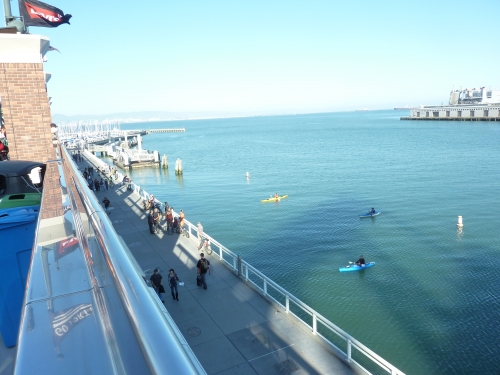
Score: 2/3
Total: 27.5/33
Functionality & Essentials
Sightlines:
The sightlines at AT&T Park are generally more problematic than most retro parks, characterized by poor seating geometry down the left field line. While San Francisco uses the same club/suite decking formula as many others, there are some slight differences in overhang as well.
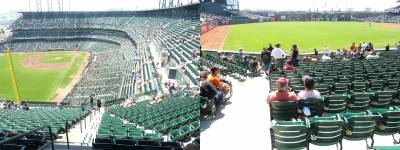
In order to preserve bay and bridge views in left field, the architects were forced to squeeze a surplus of seats in foul territory (not in outfield). Minute Maid Park, which also opened in 2000, had to do the same because of Union Station, but they were much more successful. Similar to Progressive Field or Camden Yards, every seat in San Francisco past third base down the left field line is poorly angled in some fashion.
AT&T Park most likely fails due to some sort of quirky site constraint. The seating geometry down the left field line is unlike any seen in baseball. Like Jacobs Field, the seats aren’t adequately angled down the line to compensate for the grandstand positioning. Fans will have sufficiently stiff necks from sections 129-132 and similar sections in the upper deck. The last two sections (335-336) of the left field upper deck are some of the oddest seats in major league baseball. The seats are oriented toward the infield seating considerably behind home plate, with half of the outfield cut off. Luckily, seats down the right field lines avoid all of these problems.
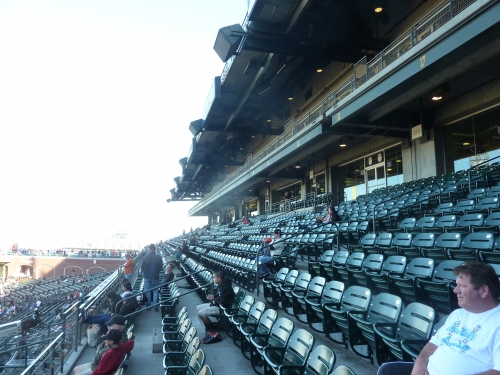
Compared to other parks of the era, the decking structure is slightly different as well. Of the early retro parks, other than Arlington, the decking might be the most pushed back, while compensating with a lower than usual decking structure. If you look closely, the club level is lower to the ground than usual. Conversely, the upper deck is slightly farther back from the action, covering very little of the club level seating. Note that all of this is very subtle, as there’s little practical difference between here and the decking in parks like Coors, Safeco, or Minute Maid.
Score: 7/10
Seat Comfort:
The seats at AT&T Park are pretty much what you see in every other ballpark in America, with two notable exceptions. All relatively tight Kelly green seats have cup holders. The first distinguishing fact is the abundance of bleachers in the outfield. This was a deliberate design choice, so as usual, I don’t count bleachers against the stadium. The main surprise is the complete lack of padded seats in the ballpark. Unlike most every other park in the majors, both the field club and mezzanine club seats are not padded. I can’t really come up with an explanation for this, other than to keep costs down, but that doesn’t sound right. Does anyone who worked on the ballpark have an explanation?
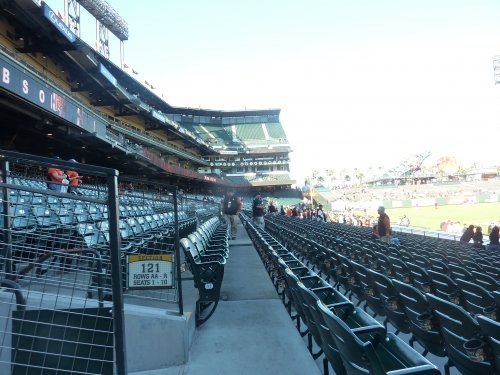
Score: 3/5
Concourses:
Hardly insignificant, AT&T Park’s primarily flaw is its extremely narrow concourses, ranging from only 25 to 28 feet in width on the main level. Despite technically being open to the field, a number of factors make this concourse system the worst of the post-1991 parks. Enhancements in 2006 somewhat improved circulation.
First of all, the main concourse isn’t at street level. While Safeco Field shows this does not necessarily have to be a flaw, AT&T Park doesn’t execute it quite as gracefully. Upon entering from the Willie Mays Plaza, you will be unexpectedly greeted by a series of cumbersome concrete ramps, similar to those of U.S. Cellular Field. It’s quite odd for a new retro park.
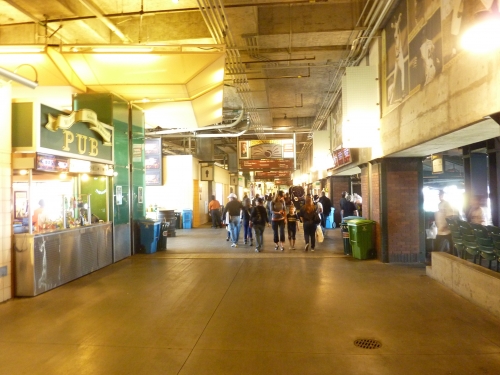
To avoid this, you also have the option of entering the ballpark at ground level in center field by the water. AT&T Park has two distinct concourses in the outfield instead of the usual one. Because the space in the outfield is so limited, they chose to make a separate area underneath the bleachers for fans, while still maintaining a 360-degree system above.
As previously mentioned, the 360-degree system is ridiculously narrow, to the point where fans are deterred from standing in line for concessions. This is further complicated by the overabundance of kiosks and concession stands everywhere you look. The main concourse gets particularly narrow in both right field and left field by the coke bottle to the point where it’s simply a passage way. Just looking at the congestion in the outfield, or even the widest points of the main concourse, we can conclude circulation isn’t properly encouraged. The upper deck concourse is narrow as well.
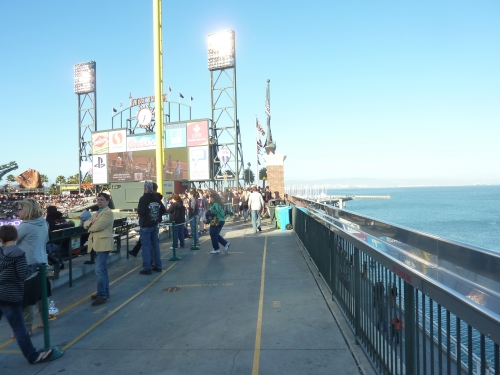
An asterisk must be applied to the label “open concourse” here because it is characterized by such poor visibility. Along with a low ceiling, prominent kiosks block views in many locations. Also note the prominent concrete beams (partly covered in brick) installed to support the superstructure, which are added for earthquake protection. In reality, it all translates to a closed concourse with open portals. It should be noted that some renovations in 2006 improved visibility by opening up some areas, so I’d hate to see what it looked like before that.
Because of the concourse system and size constraints, standing room only areas are more limited than usual. While they’re available in some form behind the bleachers and in the arcade, there’s no dedicated standing room area found in most ballparks.
Score: 2.5/7
Scoreboard System:
Throughout the 2010s, we’ve seen an arms-race between teams trying to get the biggest and best videoboard. Installed in 2007, San Francisco’s videoboard now amazingly lies near the bottom of the pack in terms of technology and size. That being said, it’s still as informative as any, showing both lineups at a time, the batter’s stats, the line score, and the pitcher’s stats. The fact that they still use a manual out of town scoreboard is appreciated as well.
The Giants responded by adding the third largest videoboard in baseball for the 2019 season.

Score: 3/3
Total: 15.5/25
Amenities & Features
Quality and Selection of Concessions:
In the stadium hospitality industry, AT&T Park is generally regarded as taking ballpark food to the next level. As I discussed in the intro, San Francisco not only offers all you could ever want in each food category, but it expands each category into particular regional selections. Like Safeco Field, it’s truly beyond anything offered at any other venue in sports. Everything’s high quality; everything’s local. A world-class city offers world-class (ballpark) food.
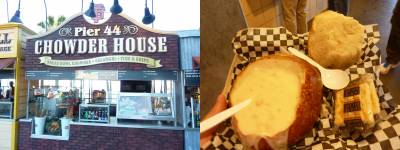
In San Francisco, you have to start with the fantastic seafood. Only in this city will you find kiosks specifically serving clam chowder served Wharf-style in a bread bowl. The Pier 44 Chowder House in center field serves a bevy of seafood options, including fish and ships, shrimp, fried calamari, and house chips. Crazy Crab’z serves AT&T Park’s piece de résistance, a decadent crab sandwich, which might be the best item at any ballpark. I’ll explain below. A crab salad is also available.
AT&T Park also has an excellent selection of Asian food. Named after the infamous Edsel Ford Fong, all of the standard Chinese items are served, including egg rolls, fried rice, orange chicken, beef with broccoli, and Chow Fun. Thai Skewers, Thai Yellow Curry Chicken, Tofu, and BBQ Pork Ribs are available. Healthy Asian Salads and an assortment of Sushi are served as well.

But AT&T Park is also impressive in areas you wouldn’t expect. Tres Agaves Mexican Kitchen serves authentic Mexican food, including torta ahogadas, tamales, and bunuelos, along with high quality nachos and tacos. Saag’s Deli is a famous local establishment; serving an assortment of delicious sandwiches, including ham and cheese, roast beef, and turkey. Of course, AT&T Park has Caesar salads as well.
Despite the replacement of Pipken’s Pit BBQ, all of the regular BBQ items are still available below the center field bleachers, such as BBQ turkey, pulled pork, brisket, and baked beans. They have been rebranded as McCovey’s BBQ. AT&T Park goes out of its way to serve everything even when it’s not really necessary! Be sure to check out the Puerto Rican BBQ at Orlando’s, which serves the Cha Cha Bowl and El Gigante hot dog, along with other items.
Murph’s Clubhouse Pub serves faux American Irish cuisine, such as Irish nachos, Irish Quesadillas, fish and chips, and corned beef sandwiches. The North Beach has the Italian cuisine, including garlic chicken sandwiches, ravioli bowls, and tiramisu. A thoughtful effort, no doubt.

While hidden below the bleachers, Stormin Norman’s Famous Frybreads is worth the trek. Not only do they sell 7 flavored fry breads, but nuttella strawberry pastries, pineapple cakes, and whoopee pies. I was amazed to see Ghirardelli, yes the famous gourmet chocolate company, in AT&T Park as well. Of course, they have an incredible wine and beer selection (like that’s an afterthought). You can even get champagne here, and not just in the premium areas!
I know I go on and on here, but its truly notable in itself. San Francisco was the first to figure out fans would rather pay super high prices for high quality food, than pay high prices for regular ballpark food. Each food stand is so good it has its own Yelp section.
In an article by Travel and Leisure, the writers surveyed “league officials, restaurateurs (Danny Meyer), chefs (including stadium supplier Aramark’s Ed Lake), and super-fans like Kevin Reichard, publisher of the go-to stadium news website BallparkDigest.com, and everyone agrees: AT&T Park is the champion of stadium food.”
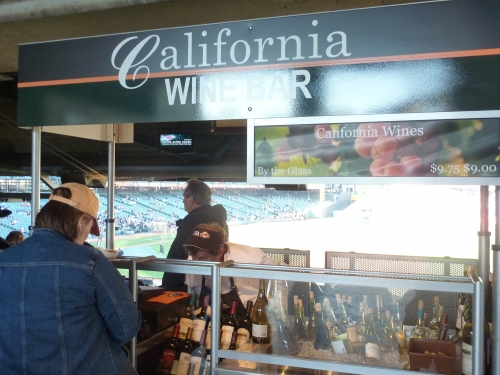
Score: 5/5
Regional/Signature Concession(s):
Everything’s a signature concession here. Need I really list them again? Everything’s high quality and local.
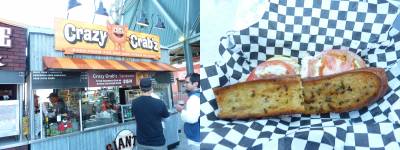
The Crazy Crab’z Sandwich is probably the top item. The most expensive regular concession item in the majors not in New York, fresh Dungeness Crab is served on grilled sourdough bread with a tomato and lemon. I can’t even begin to describe the unexpected deliciousness of this combination. I don’t even like tomatoes! It’s on the short list of items I’d buy outside the ballpark.
The Cha Cha Bowl is the other item that gets a lot of media hype, and it was originally invented here. It’s healthy, too! It comes with rice, black beans, and fresh grilled chicken topped with zucchini, carrots, and pineapple. You get your choice of four sauces: jalapeno, chipotle, habanera, and BBQ.
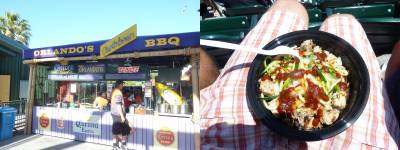
Traditionally, the Gilroy Garlic Fries have been the signature food of record at AT&T Park. It’s the one food I didn’t sample, but they’ve generally gotten mixed reviews.
In 2013, the Giants added Original Joe’s, a classic San Francisco restaurant serving their famous burgers. Joining them is Lefty O’doul, another well-known local establishment.
Score: 2/2
Public Restaurants/Bars/Sitting Areas:
AT&T Park has two full service restaurants side by side behind the first base concourse. Public House is a year round sports restaurant and bar serving typical American cuisine. The second restaurant is Mijita, a taqueria serving authentic Mexican food. The center field plaza behind the scoreboard is filled with metal tables and chairs, serving as the primary eating-place for fans inside the park.
In 2014, the Giants debuted “The Garden” beyond the centerfield wall in front of the scoreboard, and yes, it’s just what it sounds like, and more. Featuring two bistros, a bar, dining tables, benches, and fire pits to go with world-class healthy fare from freshly picked fruits and vegetables, it’s a prime example of how AT&T Park stands out in providing over-the-top amenities. The menu includes flatbreads from the pizza oven, tossed-to-order salads, antipasti (like herb-marinated olives and hearth-roasted nuts), fresh-fruit smoothies, sandwiches, and garden soups, all of which is harvested from The Garden. Fans can also bring their own food to picnic on the lawn in front of the centerfield fence. Watch out for home run balls though! (there is a net).
While this new “Garden” helps make up for it, AT&T Park is one of the few post 1991-ballparks to lack some sort of eatery or tabled seating area with a field view. The ballpark also lacks the social spaces and areas to hang out and watch the game of others. But with the spatial constraints, it’s remarkable they incorporate the amenities they do.
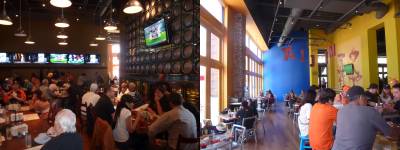
Score: 3.5/5
Premium Seating/Clubs:
As a ballpark that needed sufficient revenue for private financing, AT&T Park took the standard for premium clubs to an entire new level in both quantity and quality for their time. Because of the site constraints, the Giants were forced to get creative with some of their secondary options as well. Despite lacking a true all-inclusive ultra-premium space, the Giants continue to be in the upper echelon of premium seating, especially with the addition of the Gotham Club in 2014.
In the late 90s, premium sections behind home plate began to catch on, often known as “Diamond Clubs.” The renovated Angel Stadium was the first modern ballpark to incorporate this concept in 1998. Safeco Field was the first new ballpark to have a premium home plate section with it opened in 1999. Every new ballpark that opened in the new millennium has one, with the exception of Miller Park and Comerica Park.

Despite forgoing the ultra-premium all-inclusive model, AT&T Park took it to a new level in 2000 with thousands of “Field Club” seats, ranging from dugout to dugout. Extensively upgraded in 2006, the club lounge has a distinct vibe resembling a luxurious California kitchen. Appointed with cherry-wood paneling and dark orange tiles, the lounge area’s “view cooking” stations are a can’t miss. The décor’s lighting is particularly dark. Note the baseball murals as well. Access to the space is particularly unique: to get from the lounge to your seats, you pass through the service level where fans can congregate to see players go to and from the clubhouse.
In 2007, they added the Lexus Dugout Club in front of the existing field club seating. While no additional lounge was added, new padded seating includes wood panels, TV monitors, and drink rails.
The Giants finally added an uber-premium space at ground level in the place of a former umpire locker room for Lexus Dugout Club ticket holders. The Blue Cross Field Club which sits above this new space behind home plate has been renovated for 2019 as well.

Nicely juxtaposed with the rich dark décor below, AT&T Park’s mezzanine club space (known as the Virgin America Club Level) is characterized by light shades of pale yellow. Perhaps recalling the warm ochre color of the northern California summer hills, an associate for HOK describes the décor as a “Tuscan color palette.” In 2000, both AT&T and Minute Maid took these mezzanine club spaces to a new level in luxury. If you are a foodie, unless you specifically crave fruit, San Francisco is a ballpark where there’s little upgrade in food when you enter a premium area, because the general food is so good. The club features a number of historical memorabilia and a truly captivating bay view on the right field side at the end of the concourse. Field club patrons have access to this club as well.
The Giants offer a number of unique premium concepts. As previously mentioned, Triples Alley is a party area in right center where fans can be on the warning track during batting practices. The “Virgin America Loft” is my absolute favorite idea, evoking an urban San Francisco loft nestled in the arches in right field. The bullpen suite is pretty cool as well.
In 2014, AT&T Park added the Gotham Club, billed as the most exclusive membership-only club in baseball. Simply put, there is nothing else like it in baseball. This is a supremely upscale club, smelling like old money and rich baseball history.
When membership was originally offered to season ticket holders, the initiation fee was $2,500 with $1,250 in annual dues, which isn’t to bad compared to the $1,000 in annual dues at the Stadium Club at Guaranteed Rate Field. Located inside the out-of-town scoreboard in right field accessible via a private entrance from the Portwalk, members get exclusive access to a speakeasy style lounge with a stunning bar and dining area known as “The Clubhouse.” Featuring chandeliers and captivating views of McCovey Cove and the field, the lounge space is an incredible warm and welcoming place. Note the bookshelves of Giants history. There is both a bar bites menu and a full menu. If you ask, you’ll be allowed to change the numbers on the out-of-town scoreboard. The bar also stays open “well past the final out.”
Directly accessible from the Clubhouse, fans can go onto the field to the “Bullpen Booze Cage” before the game to watch batting practice. Finally, “The Game Room” is an exclusive entertainment space located on the suite level (which is a smart idea to induce suite holders to join as well). Inspired by the pool halls owned by John McGraw, this secret room features bowling, a billiards table, parlor games, and arcade games. Decked out in a speakeasy style decor, it’s an ideal place to celebrate after the game. All areas are filled with old Giants history dating back to their Gotham days.
The Gotham Club is probably the most exclusive club in the majors, judging by ability to get in if you aren’t a season ticket holder even assuming you have unlimited money. Unlike premium home plate clubs or other club seats, where single game tickets can be bought on the secondary market for $250-$500, or membership Stadium Club restaurants, where single game passes can also be bought on the secondary market, it appears to be impossible to get into the Gotham Club unless you know someone. To give you the obvious direct point of contact, I will never be able to get in here unless I know someone in San Francisco.
Why? Unlike other exclusive clubs requiring passes, the Giants have a way to ensure fans not formally endorsed with the Giants by members can’t get in. Depending on membership level, members get guest passes, and guests must either (a) be with them, or (b) registered with the Giants as “pinch hitters” in the case that the actual member is not at the game. If members wanted to give their original membership pass to someone else for a game, they would also have to register them as “pinch hitters.” So in other words, if a member wanted to sell a guest or original pass for a game, not only would they have to sell it, they would have to register the person they sold it to with the Giants. Needless to say, this is unparalleled in baseball, and I doubt a member would go through this process with a stranger. Members who have tried to sell them have been punished. Yes, there may be “better” club seats or club spaces (like the 1st row Legends Premier at Yankee Stadium, which can go for $2,000 on the secondary market), but this is the most exclusive and hardest to get into in all of baseball.
AT&T Park has some of the best premium seating in baseball, including the most exclusive club.
Score: 5/5
General or Artistic References to Baseball or Team History/Museums:
For not having any area specifically dedicated to Giants history on the inside, AT&T Park does quite an impressive job in recognizing the Giants’ long and illustrious history. But for such a historic team, you’d think they’d find some space for a museum.
Knowing this, AT&T Park compensates by literally integrating some sort of historical touch everywhere you look. Baseball themed quotes are located on nearly every wall and entry point. I’m talking inside, on, and around concourses, ramps, elevator entries, concession stands, ceilings, etc. It was a surprisingly nice touch.
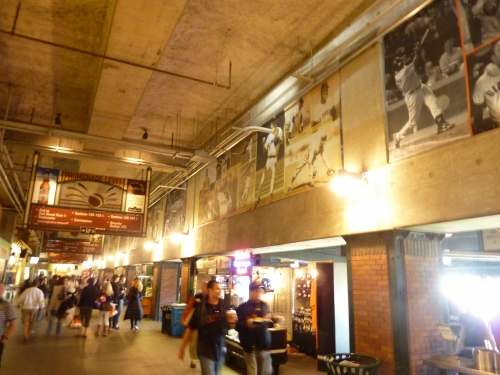
Historical murals and timelines are located on every concourse. On both the main and upper deck concourse, there are historic Giant murals on the walls above and around concession stands. Below the bleachers, there is a timeline of Giants history. I have often said that bringing references to team history to the average fan throughout the concourses is just as good, maybe even better, than having a team museum. The Giants really succeed in the former aspect. The club level has an impressive series of pictures and a permanent display area behind home plate showcasing memorabilia.
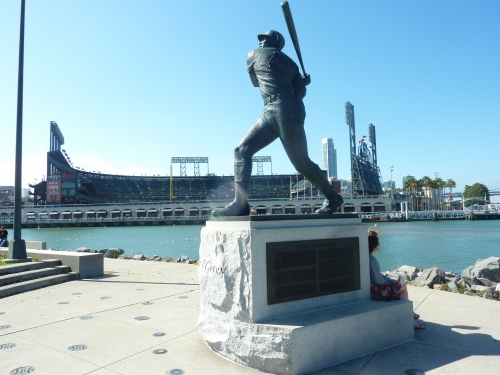
The Giants “wall of fame” is located on the outer wall of the ballpark on King Street, recognizing retired players with historic records. The Giants’ History Walk, situated along the port walk, displays a series of bronze plaques recognizing significant moments in ballpark history. There are multiple historic allusions to Willie Mays in Mays Plaza.
Like almost every new retro ballpark, there are a number of impressive statues outside of the structure, highlighted by Willie Mays behind home plate. There are also statues of Juan Marichal, Orlando Cepeda, and Willie McCovey. But my personal favorite is a statue depicting a seal balancing a baseball on its nose, sculpted by Alfredo Osorio.
The Giants did finally add a museum for the 2018 season. Dubbed “The Vault,” it features rotating exhibits of memorabilia spanning all the way back to 1883. This space alone is a prime destination for Giant fans across the country.
Score: 5/5
Entertainment/Kids Activities/Other Amenities:
For a ballpark so tight on space, AT&T Park was remarkably creative in supplying all fans with multiple forms of entertainment. The Coca-Cola Fan Lot is the main site of attraction. And unlike many ballparks, its not just limited to kids! (I really, really regret not going down the slide!).
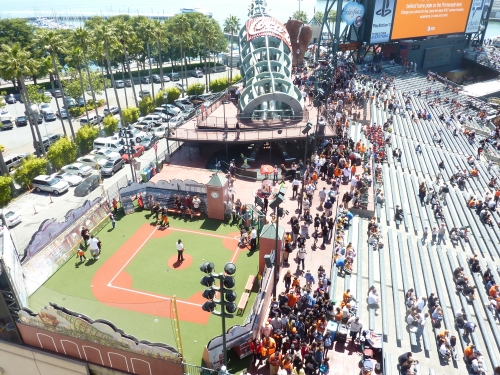
Guests can go down a slide into home plate inside of the 80 foot Coca-Cola bottle or walk right up to the famous vintage glove. Kids can play wiffleball inside Little Giants’ Park. The Lot is a great use of space. In 2013, the Giants added a social media center in place of the “Make Your Own Lou Seal” Build-a-Bear.
The concourse below the centerfield bleachers has batting cages and speed pitch. Behind home plate on the main concourse is the AT&T video game station. Be sure to check out the trolley in centerfield.
Oh yeah, and you can go bowling or play billiards at AT&T Park in the Gotham Club.
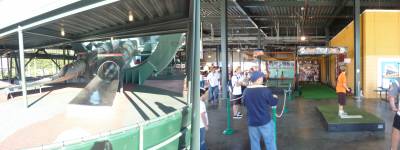
Score: 2.5/3
Total: 23/25
Atmosphere, Vibe, & Policies
Atmosphere/Fan Support:
Both the attendance numbers and fan atmosphere indicate AT&T Park has some of the best fans in baseball. I’ll go out on a limb and say Giants fans were more exuberant than any I’ve ever seen, except in Boston and New York. Of course, my visits were immediately following a World Series championship.

In terms of attendance, AT&T Park is the greatest example in America of how a new ballpark can single-handedly boost fan support. The Giants were reasonably successful throughout the late 1990s, consistently in the race including a division title in ’97. They never climbed above 25,000, including 20,000 in their division-winning year. But win or lose, fans have always showed up by the bay, selling out nearly every game from 2000-2007, despite not being competitive in the last of those three years. Even after Bonds left in ’08, their nadir was never below 35,000. I have a feeling AT&T Park’s aesthetic appeal had to play some factor.
Score: 5/5
Ballpark Policies/Customer Service:
It’s odd that only New Yankee Stadium has gotten such loud criticism for its policy of not allowing all fans behind the dugout to get autographs before the game, even if they don’t have a ticket. That’s right: AT&T Park had the first “moat”; they’re just much better at hiding it. The divide between the field club and the regular seating is subtle, but the club seating extends from past each dugout-to-dugout, restricting average fans from getting autographs.
I guess you can’t hate the Giants too much. This is the only ballpark where you can watch the game for free along the boardwalk in right field.
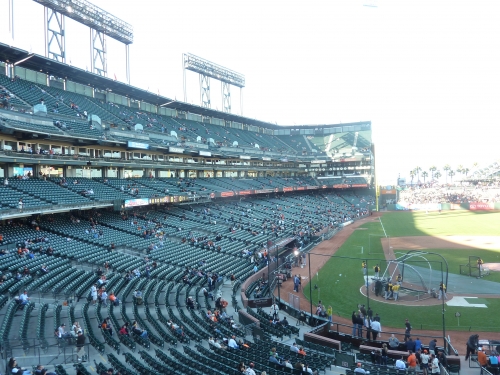
Score: 1/2
Bonus:
For building a ballpark that has perfect appreciation of the site, from the ballpark’s dimensions to the contextual integration of the water, bay bridge, and sail boats. +2
For the best view in baseball +2
For the transcendental culinary experience +1
For the free standing room area along the boardwalk underneath the arches +1
For the splashdown homeruns +1
For Renel Brooks-Moon, the first woman PA announcer in the majors, who does an outstanding job and is probably one of the best PA announcers at the game. Really. This isn’t tokenism. She’s really that good; her voice fits the vibe perfectly. +1
For the new over-the-top amenities like the Gotham Club and the Garden +1
Score: 9
Total: 15
Conclusion
Camden Yards is generally seen as the poster child of the ballpark building boom. But in many ways, AT&T Park is the biggest success story of the era, constructed with private financing and generating a huge boost in attendance. Like I said, no ballpark transformed a team and its fan base quite like this. Once you couple these factors with transcendental water views and amazing amenities, you easily have one of the best ballparks in baseball.
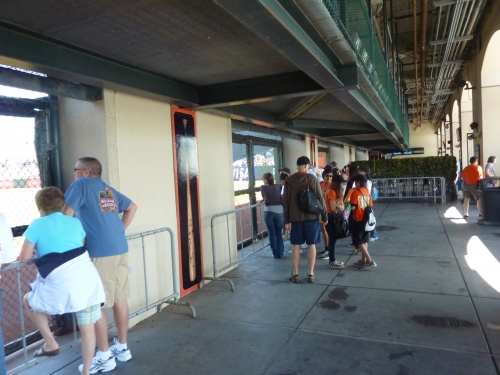
However, AT&T Park is greatly hindered by its functional flaws. While minor, they add up in the aggregate; the Giants are actually last in the “functionality” category. The concourses are indisputably the worst of the new parks and the flaws in seating geometry down the left field line are significant. The small footprint inevitably had a detrimental effect. Of course, all of this is offset by the high score in the “amenities” category, along with the obviously high score for aesthetics. Generous bonus points are awarded for the transcendental qualities of this gem, as features such as the water views and the food quality burst the 5 point scale, so far above anything seen at most other ballparks. Heck, places like the centerfield garden and the Gotham Club are far above anything seen at any other park.
Again, AT&T Park is really a ballpark of extremes, but the good is far more extreme than the bad, and far more consequential.
So while functional flaws probably prevent it from ever being number 1, AT&T Park will annually be one of the top 2-5 ballparks in baseball.
FINAL SCORE: 92.5
RANKING: #3/30
Summary
TL;DR? Here’s the long-form piece in a nutshell:
Largely by virtue of its bayside location, splashdown home runs, and postcard views, Oracle Park is widely considered one of the two best ballparks of the post-1990 building boom, alongside its contemporary in Pittsburgh. But Oracle Park is more than a ballpark with water views.
It’s a fantastic park even not considering the view, which is fortunate because unlike in Pittsburgh, the water and city landmarks aren’t visible from the lower bowl seating. Oracle Park’s amenities are just as good as its famous aesthetics and location.
Consider all that makes the Giants’ park outstanding independent of its locale: (a) some of baseball’s most delectable food and craft beer, (b) unique social spaces like The Garden, (c) one-of-a-kind premium spaces like the Gotham Club, (d) historical tributes like The Vault, (e) family-friendly features like the Fan Lot, and (f) baseball’s third largest videoboard.
Just as importantly, San Francisco’s privately financed palace could be construed as the most successful ballpark of the era, generating the most enduring attendance boost of any ballpark in modern history.
Stemming from its tight footprint, a handful of fairly serious logistical shortcomings prevent me from ever ranking Oracle #1, namely the unacceptably narrow concourses and quirky seating geometry affecting 7,000+ seats down the left field line.
But Oracle Park will continue to be one of America’s most magnificent ballparks for years to come.
Defining Features
McCovey Cove, Splashdown Home Runs, and Views of the San Francisco Bay
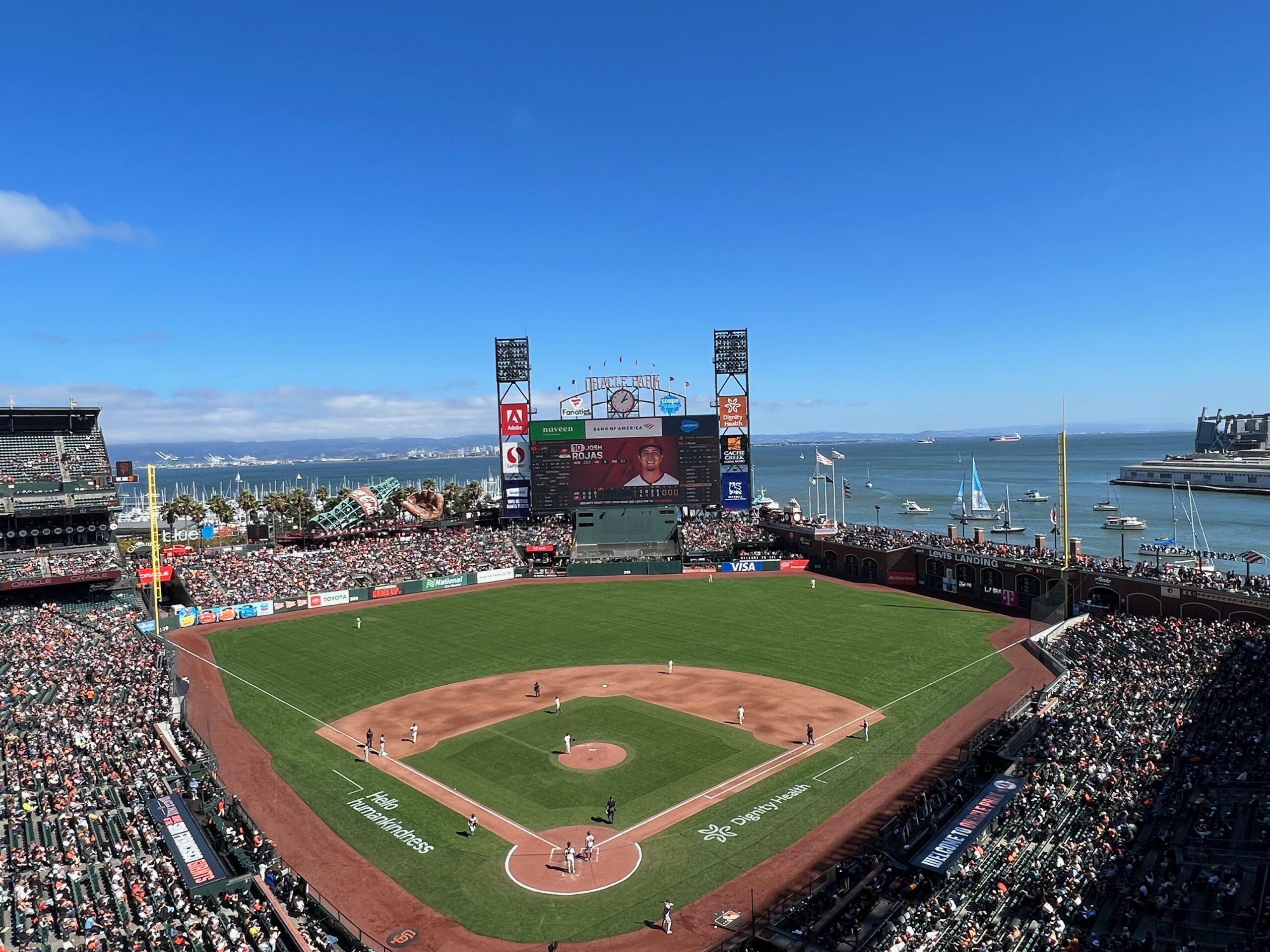
Coke Bottle and Giant Glove
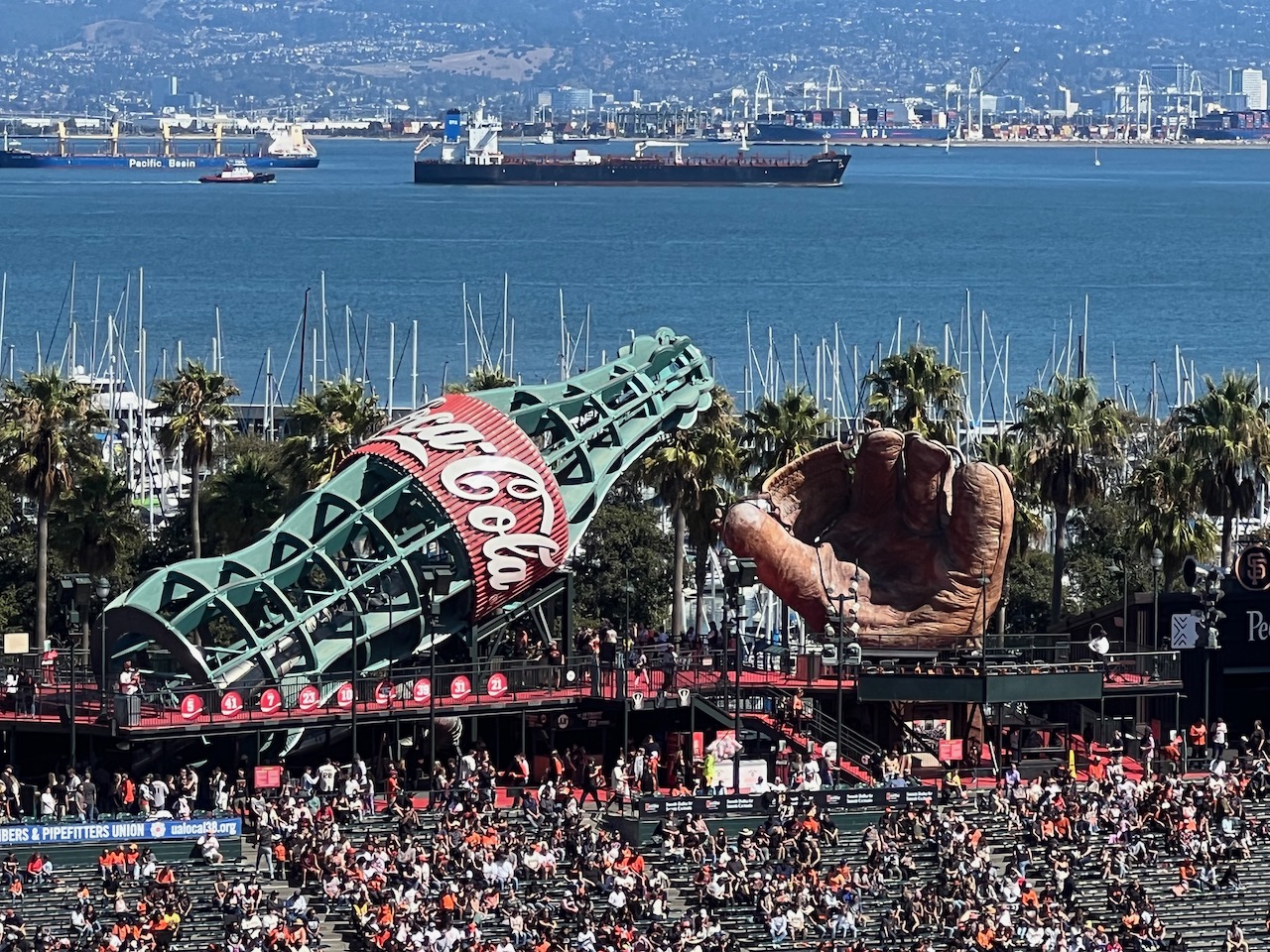
Biggest Hit
McCovey Cove, Splashdown Home Runs and Views of the San Francisco Bay

While Oracle Park is “More Than a Ballpark by the Bay” with amenities on par with the aesthetics, let’s not overthink this: McCovey Cove will always be Oracle Park’s signature feature. The short porch in right field situated 309 feet from home plate runs parallel to the water, so the park’s dimensions are authentically dictated by site constraints. Fans sit in kayaks waiting catch a “splashdown home run” landing in McCovey Cove. When looking at the view itself, Oracle Park is more than just gorgeous blue water. It’s the perfect picture. On the left field side, note how the ballpark perfectly integrates the sailboats and palm trees. Note the Berkeley Hills beyond the water. You couldn’t imagine a scene that better represents the Bay Area.
Biggest Miss
Narrow Concourses

Oracle Park doesn’t have many flaws, but its few flaws are significant. The biggest flaw is the narrow concourses. 20 or so feet short of the standard width for stadium concourses, the park experiences constant bottlenecks in circulation. Right and left field are basically narrow passage ways. Here’s a typical main concourse in Baltimore. Top left is Oracle’s main concourse. Here’s a typical outfield concourse in Philadelphia. See top right and bottom left for Oracle. Is it foolish to focus on this considering that these tight site constraints are dictated by the bay and the urban landscape, both of which make Oracle so charming? Maybe. But space matters, and the concourses are so narrow that getting around Oracle Park is genuinely a chore. I can’t overlook a problem of that magnitude.
Other Hits
Gorgeous Arched Promenade in Right Field

Oracle Park’s interior aesthetics are beautiful independent of the bay views. Archways are a hallmark of retro red brick facades, but only two neotraditional ballparks have integrated them inside. Oracle does it best. It’s also a subtle nod to nearby Berkley Stadium. The out-of-town scoreboard and the Gotham Club Clubhouse sit within the archways.
Right Field Arcade

The Arcade may be a tight and crowded area, but it sure is special to stand 10 feet from the outfield fence on one side and overlook the water on the other. The area to the right of the yellow line nearest to the bay with the drink rail is designated for standing, so this is a scenic spot to enjoy a cold one (and maybe catch a home run ball) before the game.
Giant Glove and Coke Bottle
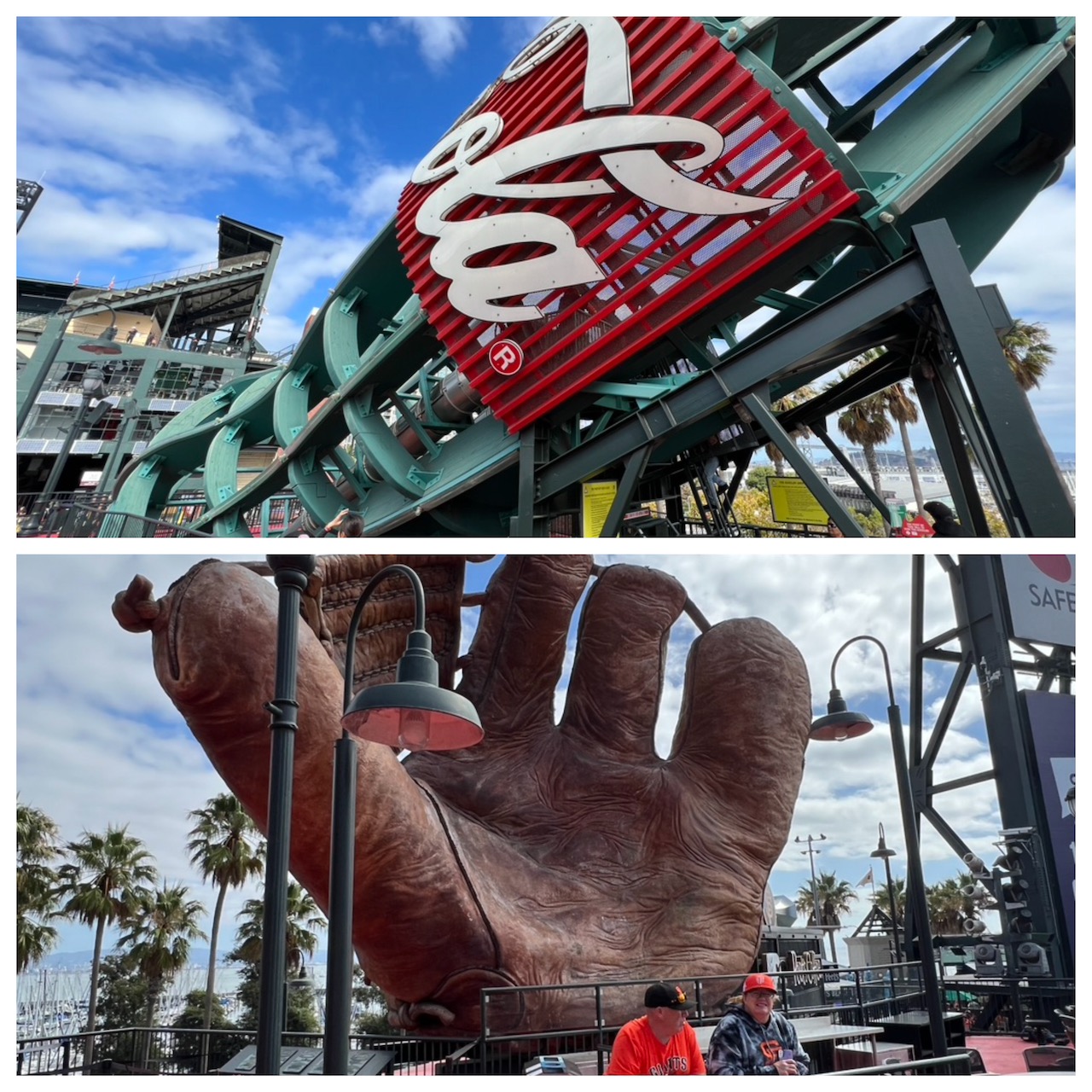
I’m usually not a fan of gimmicks spread across an outfield scene, however common it is across MLB. But Oracle’s glove and coke bottle feel right. Among a monotonous scene of left field bleachers, a touch whimsy is just what the doctor ordered. The vintage 1927 four-fingered baseball mitt made of steel and fiberglass looks classy. The 80-foot coke bottle is both attractive and functional, housing four playground slides for kids.
Exterior Architecture That Fits in With the Warehouse-Filled Neighborhood Like a Glove

I’m mixed overall on Oracle Park’s exterior architecture – a neotraditional copycat sure is a conservative call considering the eclectic architectural tradition of San Francisco – but the neighborhood context makes it a totally defensible stylistic choice. Rows and rows of red brick warehouse-like buildings dot the area, so Oracle blends in with the urban fabric brilliantly.
Willie Mays Plaza
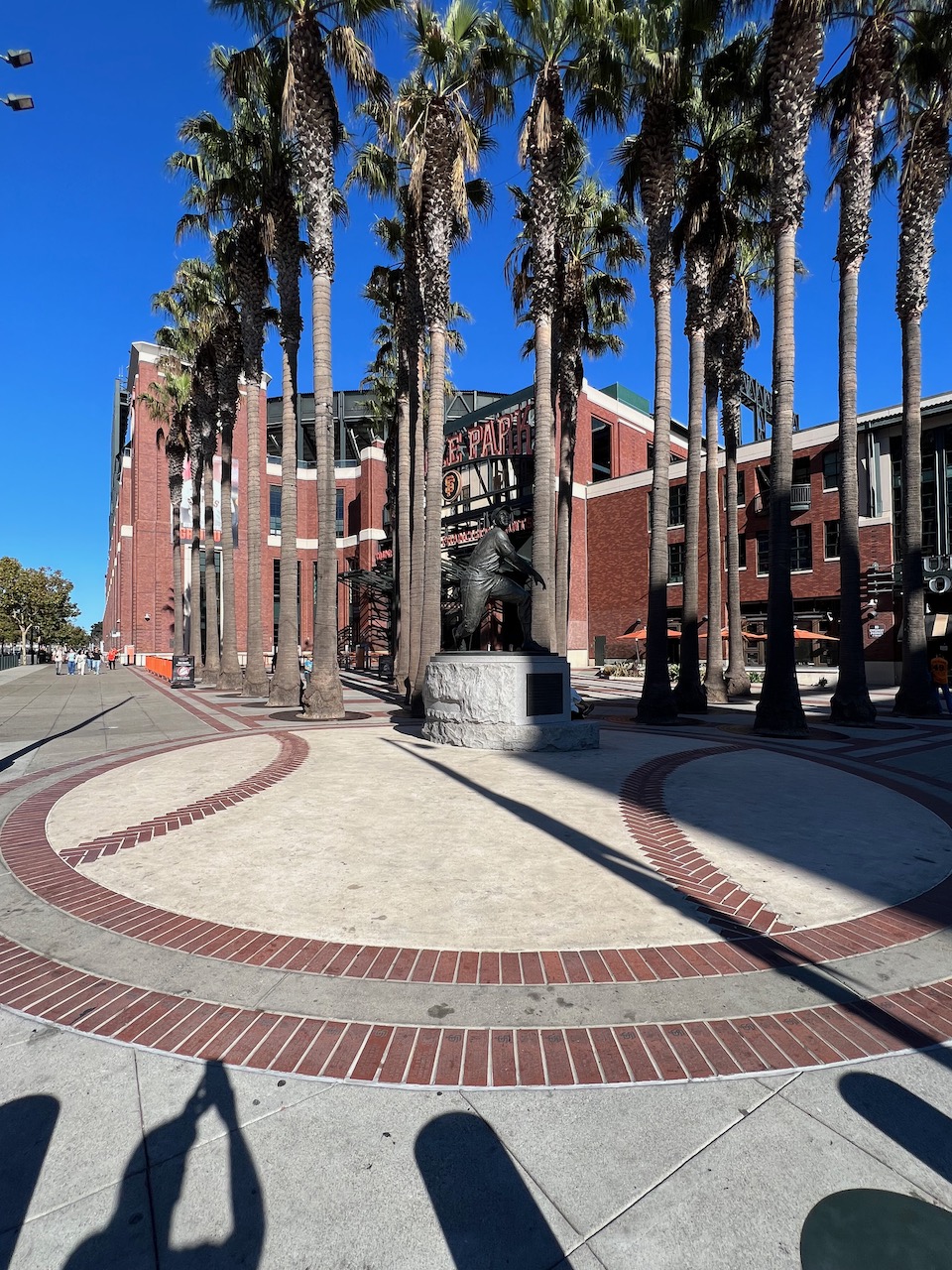
Simply one of the most iconic entrances in Major League Baseball. Anchored by a statue of the Say Hey Kid and 24 (hey, that’s his number!) palm trees, the Willie Mays Plaza creates an immediate sense of arrival. An impressive piece of urban design.
Fan Lot
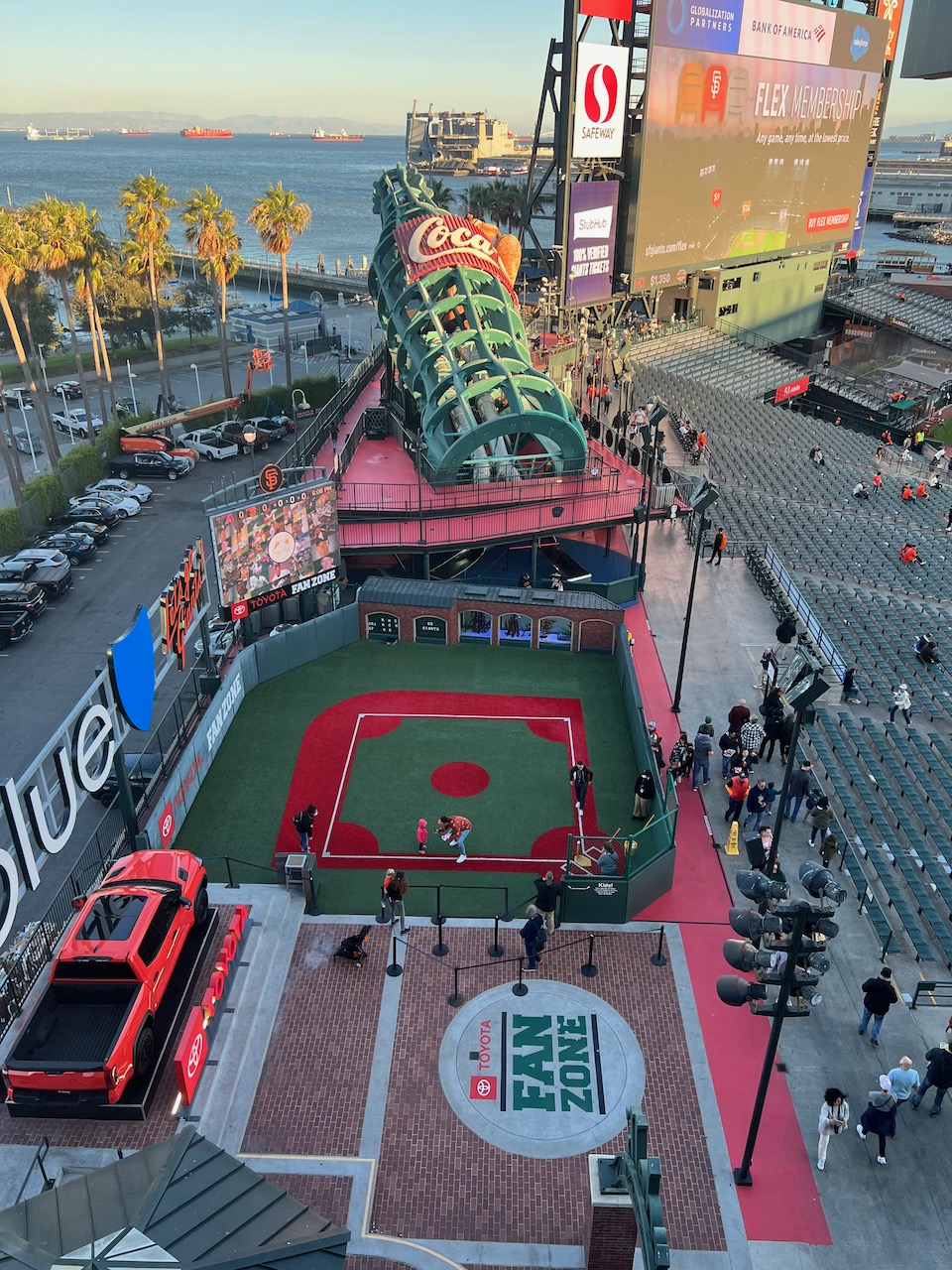
Ballpark traditionalists and curmudgeonly fans hate stadium kids areas. But you have to appreciate how Oracle’s “fan zones” are subtly interwoven into the ballpark’s underlying appeal. The aforementioned coke bottle is a jack of all trades – (1) aesthetically pleasing design element, (2) generates ad revenue, and (3) houses four playground slides for the kids. A wiffle ball field with an aquarium(!) lies at the base of the slide. Given the site constraints, this is another impressive design coup.
Top-5 MLB Ballpark for Food

The selection of grub has slightly taped off in recent years, but there’s still plenty to choose from, and the quality continues to get better in some respects. Top left: Crazy Crab’z Sandwich, my favorite item in all of MLB; Top right: Clam Chowder in a Bread Bowl, delicious and so San Francisco; Bottom Left: Gilroy Garlic Fries, overrated but a staple; Bottom Right: Super Duper Burger, one of baseball’s best burgers. Not pictured is some of baseball’s best pizza by Tony G, the Orlando Cha Cha Bowl, and Filipino spring rolls.
Top-5 MLB Ballpark for Craft Beer
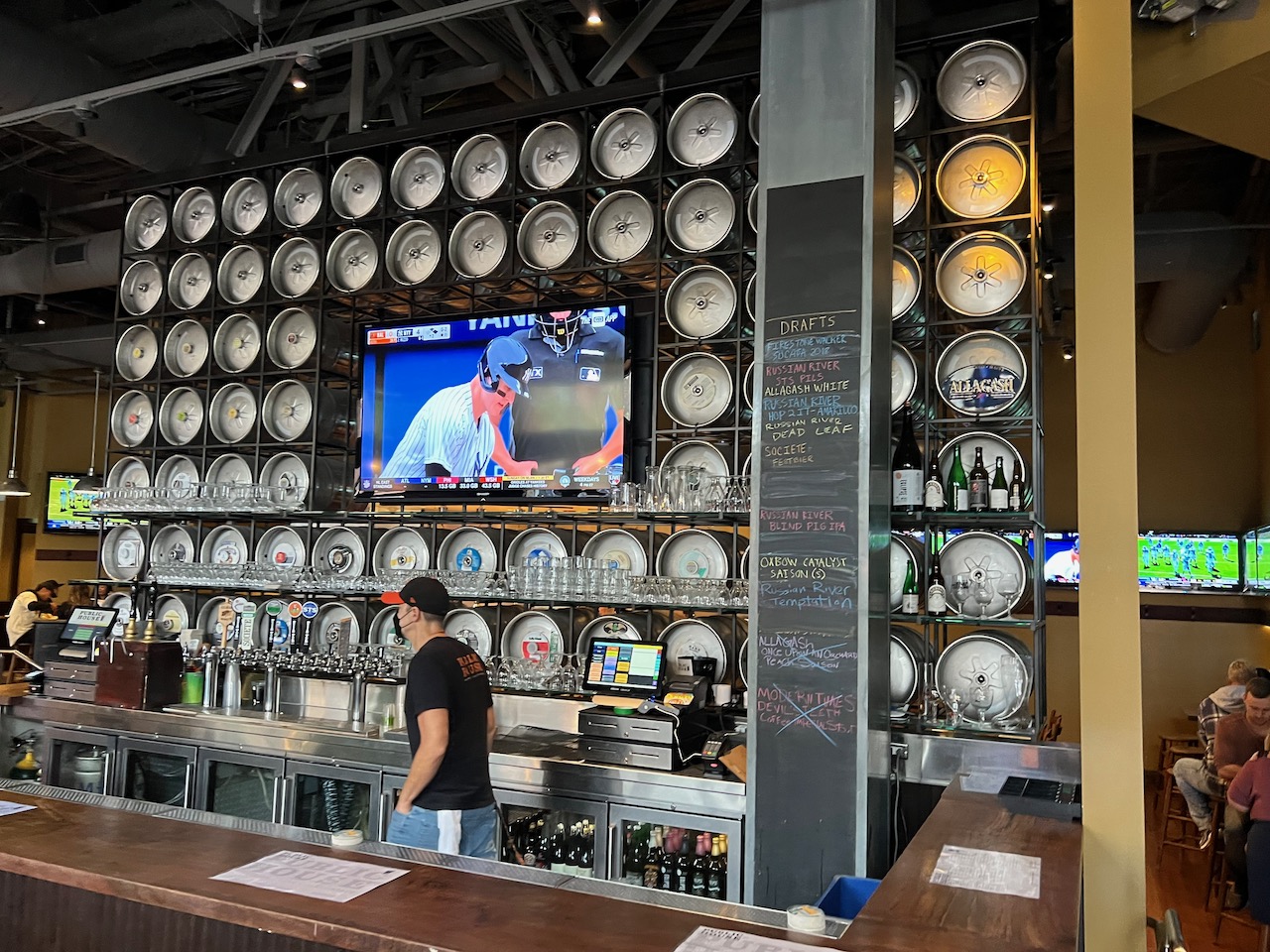
Canned beer from several Bay Area breweries are spread around the ballpark, and the “standard” suds at Oracle are solid: Sierra Nevada, Anchor Steam, and Lagunitas. But Public House, the street level restaurant and bar adjacent to the Willie Mays Gate, is the best place to get a craft beer in MLB, full stop. It offers 24 rotating beers on tap and over 75 bottles — 80% of which are local. Public House is a bit hard to get to from the main concourse, hence why it doesn’t elevate Oracle to #1 in this category, but it is technically accessible to all fans in the park.
3rd Largest Videoboard in MLB (as of 2022)

A crystal clear 4k video display paired with those crystal clear bay views is hard to beat.
The Garden
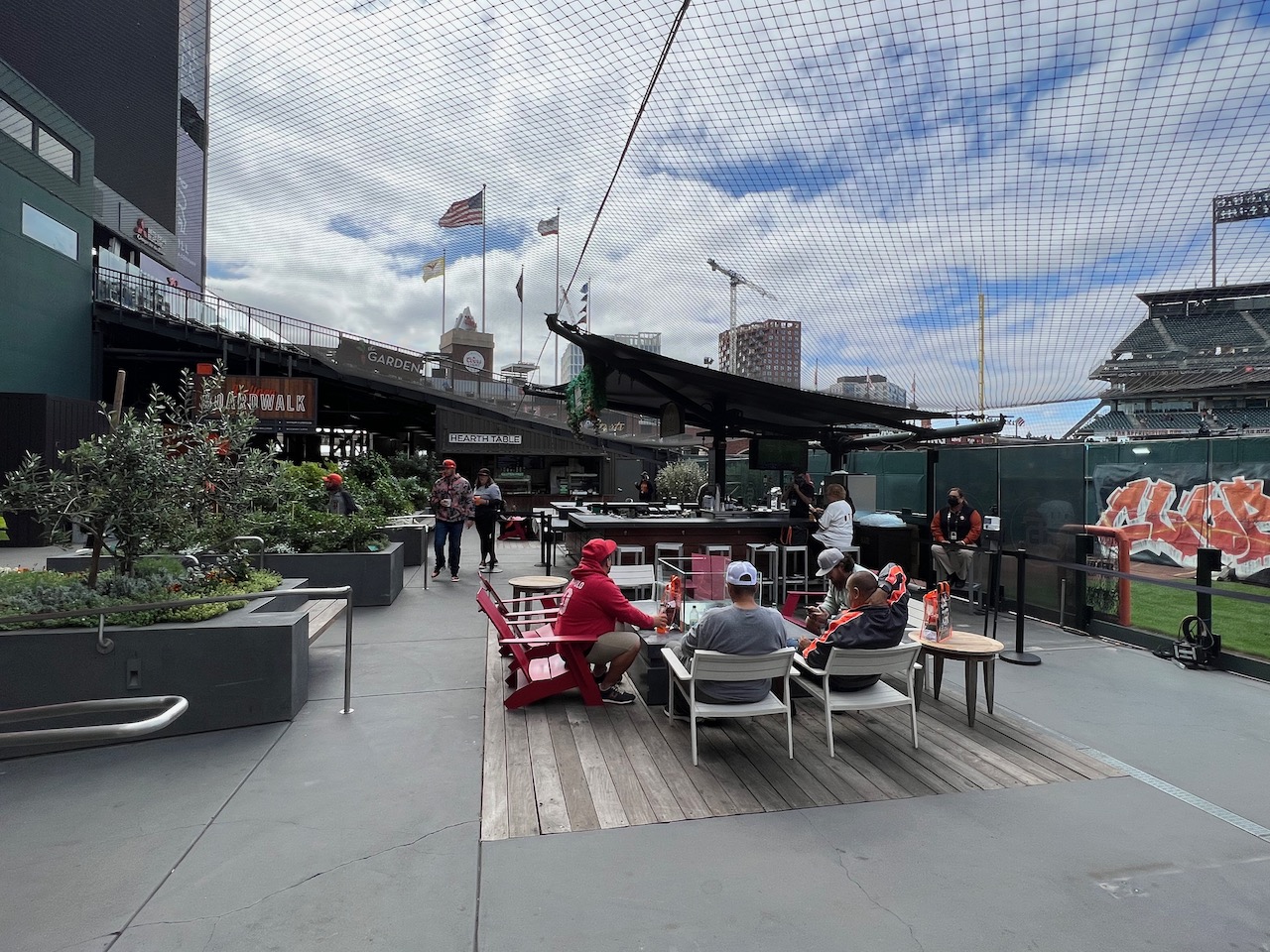
That’s right, a 4,320-square-foot edible garden sits behind the center field wall. Featuring two bistros, a sit-down bar, tables, benches, and fire pits to go with world-class healthy fare from freshly picked fruits and vegetables, it’s a prime example of how Oracle Park stands out in providing over-the-top amenities.
Gotham Club

The Gotham Club is baseball’s most exclusive private membership club, where you can’t get in by buying tickets or passes on the secondary market. Membership includes access to three spaces: (1) The Clubhouse, a decked out restaurant and bar within the out-of-town scoreboard in right field, (2) The Game Room, a bowling alley, pool table, and more on the suite level, and (3) The Bullpen, which includes pre-game on-field access to the warning tracks, a bullpen terrace, and a private perch at ground level in right field.
The Vault
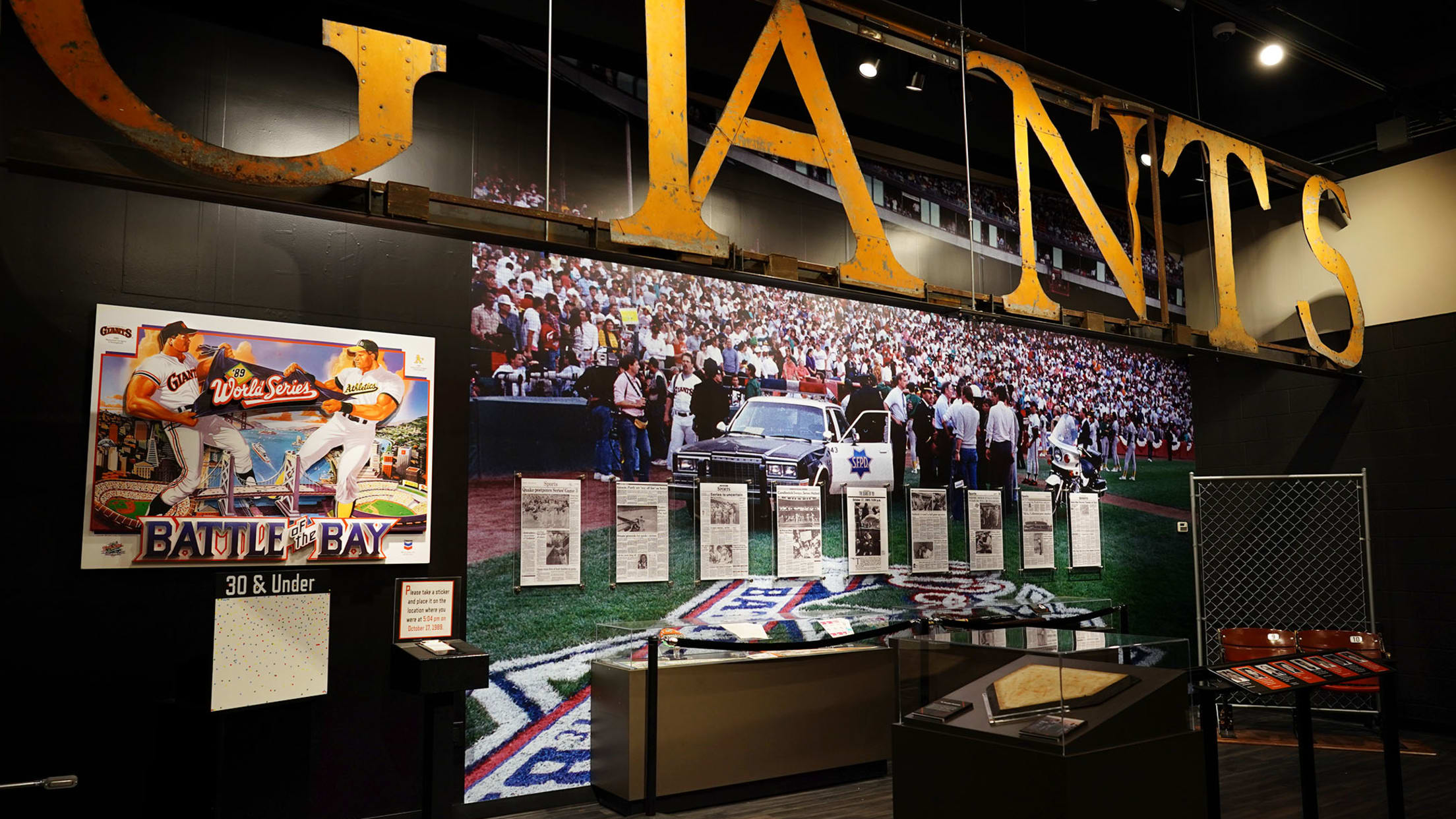
Located at ground level inside the right field gate, the Vault is Oracle Park’s museum, showcasing Giants’ history since 1883. I was told The Vault was closed for expansion in 2022, but I haven’t heard anything about reopening.
Exterior Statues
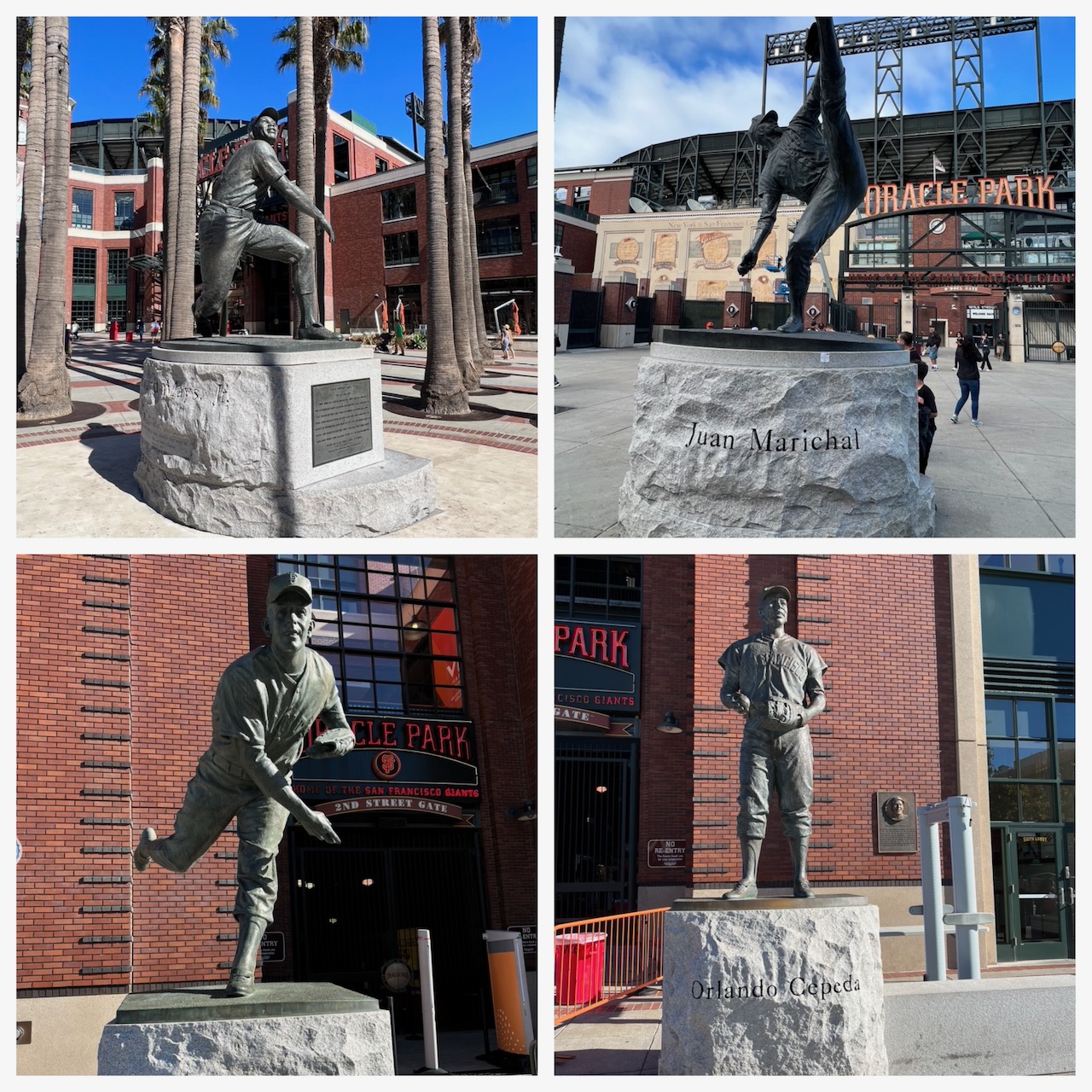
The newer Orlando Cepeda and Gaylord Perry statues are unimaginative, but the sculptures of Willie Mays and Juan Marichal are bangers.
Historical Quotes on the Walls Throughout the Interior Areas

Another prime example of the Giants’ creativity and attention to detail in designing Oracle Park. Quotes by baseball legends are inscribed seemingly everywhere, including on walls inside ramps, throughout all concourse levels, on support beams, inside club lounges, and even within elevator lobbies.
Many Other Historical Tributes, Memorabilia, Exhibits, etc.
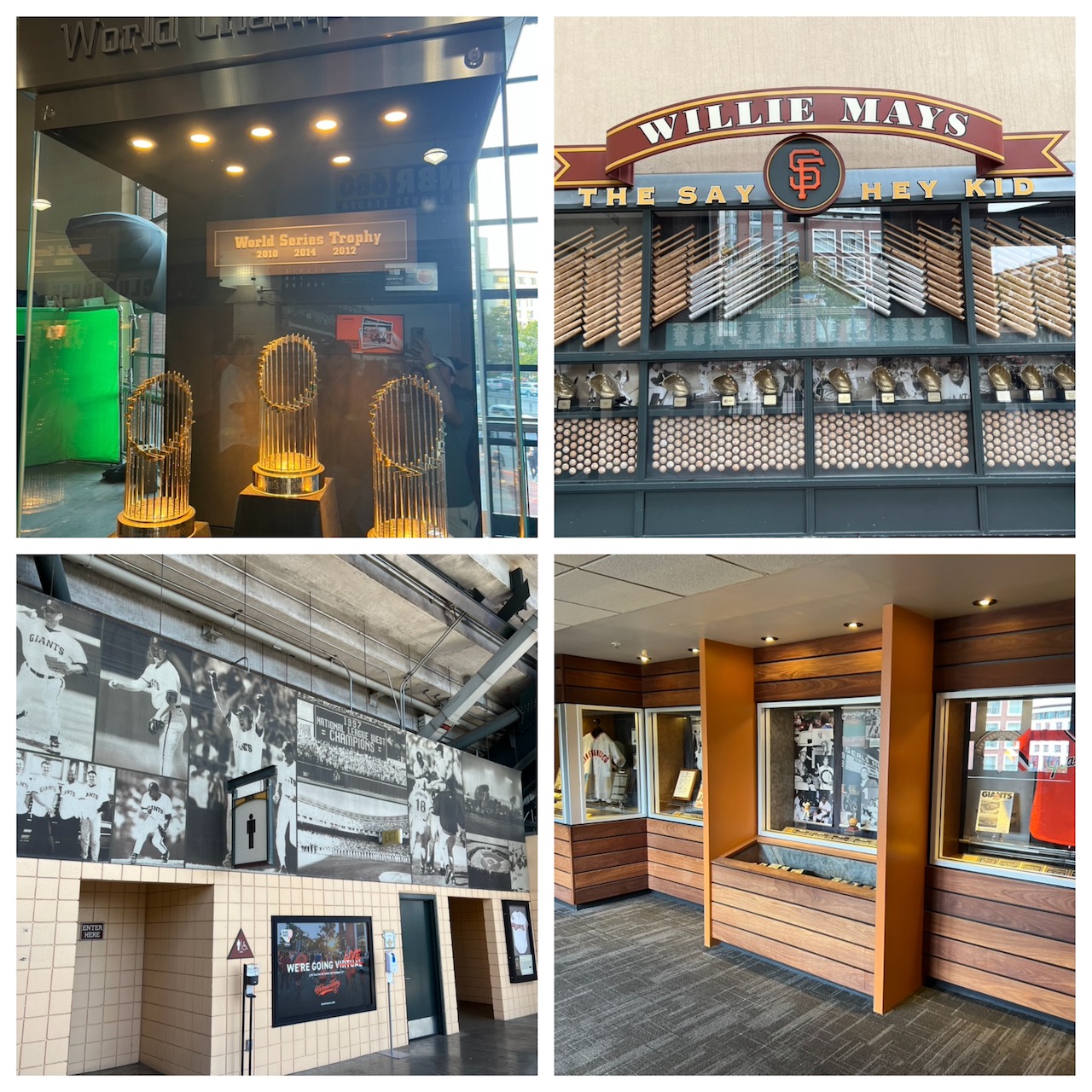
In addition to the museum and player quotes, Oracle Park showcases other thoughtful historical references throughout the concourses. Top Left: dedicated World Series trophy display on the main concourse; Top right: Willie Mays exhibition inside the Mays field level gate behind home plate; Bottom Left: murals throughout the upper deck concourse; Bottom Right: assorted memorabilia on the club level behind home plate. Not pictured are the Wall of Fame plaques outside along King Street.
South Beach Neighborhood
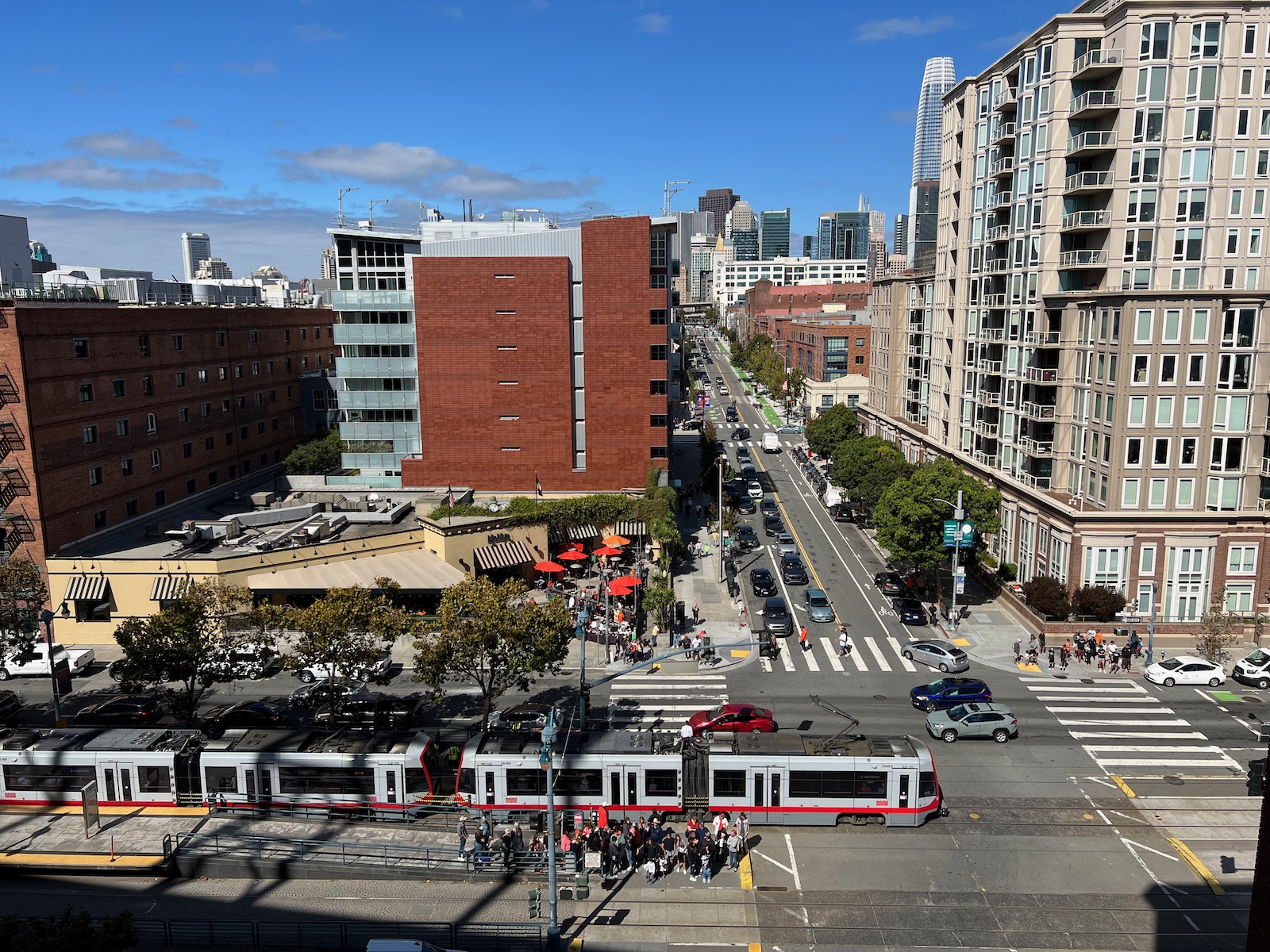
The Giants have one of the stronger pre and post-game restaurant and bar scenes in MLB, with 20 or so eateries and watering holes scattered around a four block radius in South Beach and southeast SoMa. Once Mission Rock opens across the bay, Oracle Park will have an elite local scene on par with San Diego and Denver.
Strong Fan Support Evidenced by Tremendous Attendance Numbers Throughout the 21st Century
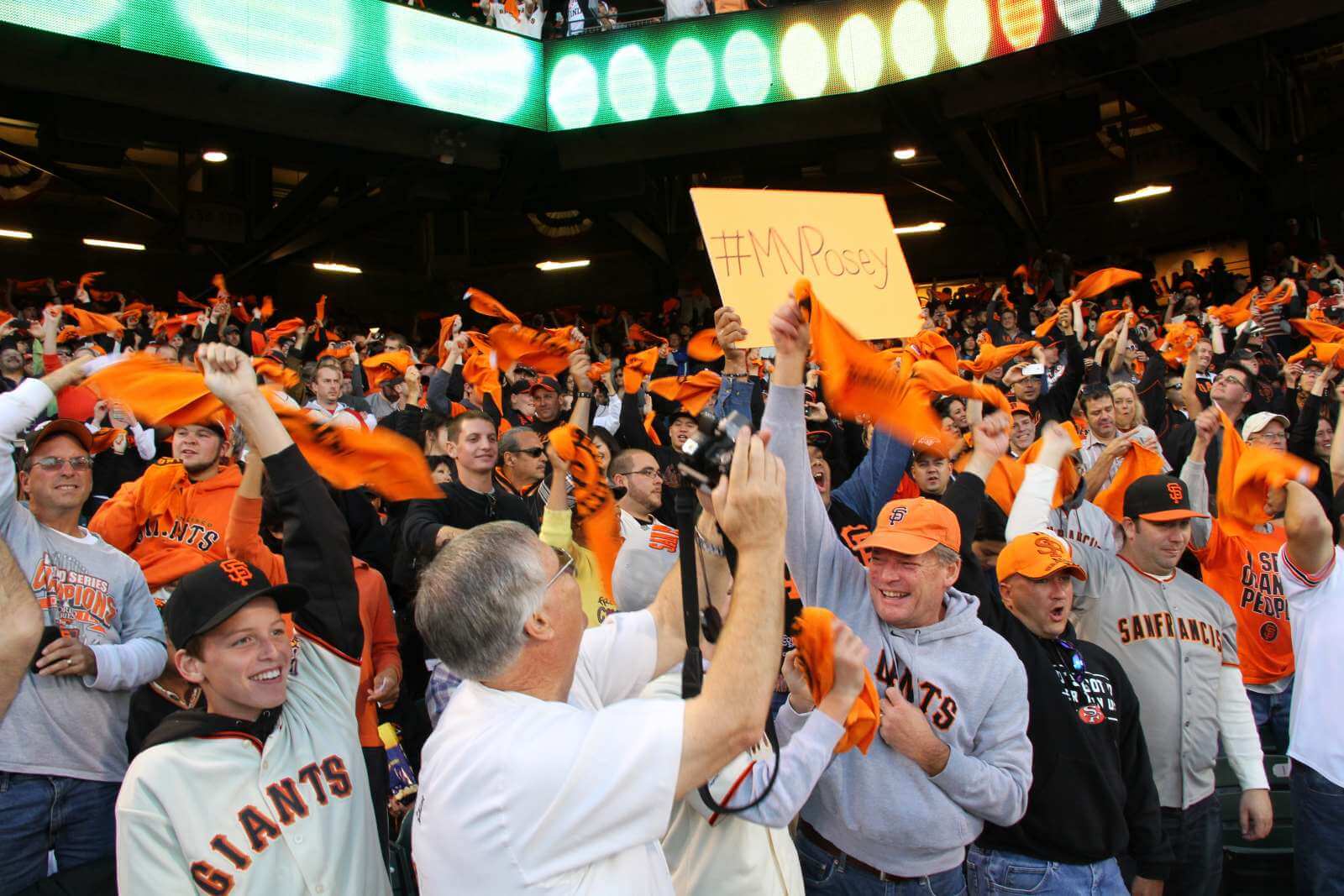
New ballpark honeymoon periods usually last 1-3 years. 5 years max if it’s coupled with a great team. Oracle Park’s lasted 18 years. The Giants sold out nearly every game from the ballpark’s inaugural season in 2000 to 2007, and then again from 2011-2017. Crucially, the post-Bonds dip in 2008-2010 never went below 35,000 per game, a number many clubs would kills to have. In the post-pandemic era, the Giants are finally seeing a more significant drop-off, but they’re grandfathered in as a 5/5 on my scorecard in this category.
Other Misses
Poor Seating Geometry Down the Left Field Line
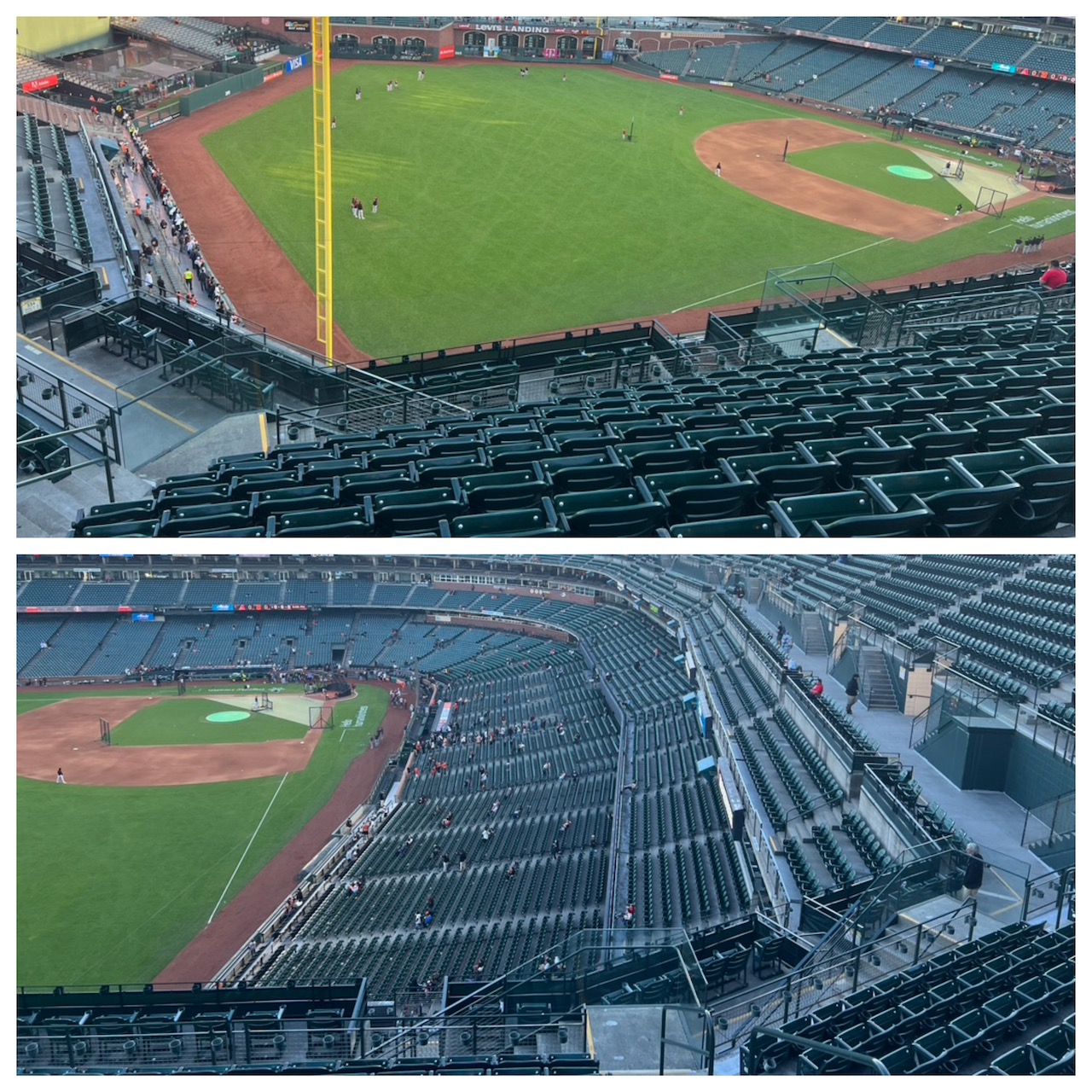
There are not many “other misses” here, as Oracle Park impresses across the board other than its two big flaws, one of which is the tight concourses outlined above. The other big flaw is the poor seating geometry down the left field line. Seats in sections 1/2/328 to 1/2/332 on all three levels aren’t oriented aggressively enough toward home plate, instead facing the outfield. Moreover, seats in sections 335 to 336 are oriented behind home plate, because the architects had to maneuver all of the upper level outfield seats in foul territory to preserve bay views.
Not Much Sense of Place From the Lower Bowl

Okay, look. This is more of a quibble than a miss or a flaw. When sitting anywhere in the lower bowl, you don’t get views of the water or the city, as the field couldn’t be sunken below street level like at other parks. Some of this is just the nature of water, but Pittsburgh managed to pull this off better. In San Francisco, when sitting in the lower bowl, you don’t know where you are until the seagulls come after the game.
Drab Main Concourse Aesthetics with Aging Graphics and Signage
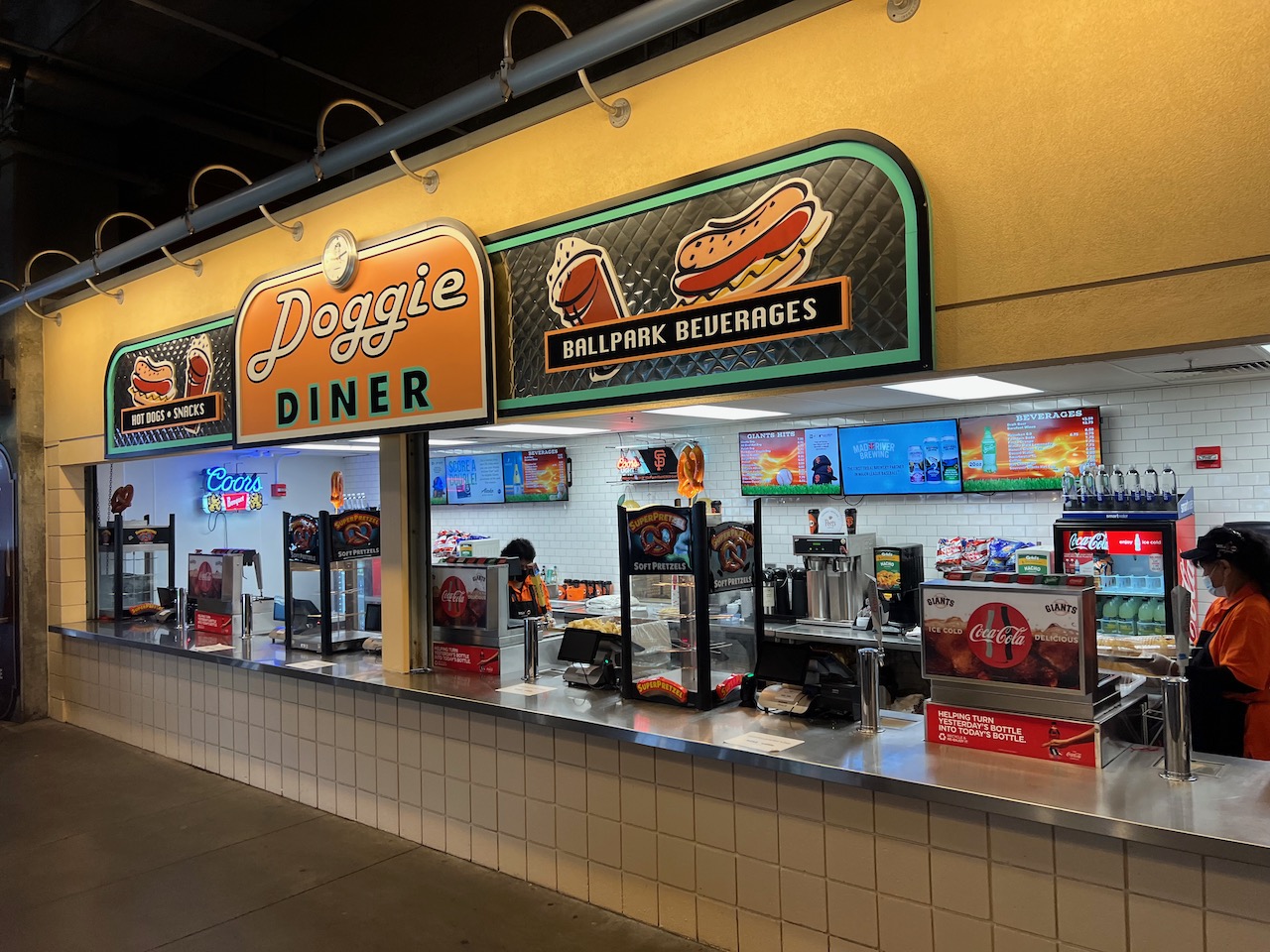
Many of the concourse graphics, signage, and other displays date back to when the ballpark opened in 2000. It’s starting to look a little outdated. The main concourse itself is also oddly dark and overloaded with concrete, not matching the retro-classic or nautical aesthetic throughout the rest of the park. Overall, Oracle’s concourses simply aren’t attractive, except in the spots where you can see the bay. Pittsburgh does this better.
No More Free Game Views
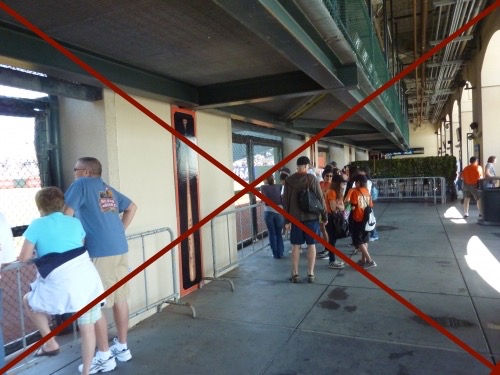
In a city and ballpark known for its sky-high prices, the Giants used to offer free views of the action on a first-come first-serve basis under the arches at the base of the 24-foot-high brick wall in right field, which abuts the boardwalk along McCovey Cove. It was reminiscent of the Knothole Gangs of the old-time ballparks. Interestingly, the the Giants website and media outlets still advertise this as a thing. But since the pandemic, the area that provided free game views was quietly discarded and hasn’t come back as of October 2022, as all I see now is a bike valet, an entrance to The 415 season ticket area, and the Gotham Club bullpen. Boo!
Best of
Best Neighborhood Restaurant/Bar: MoMo's
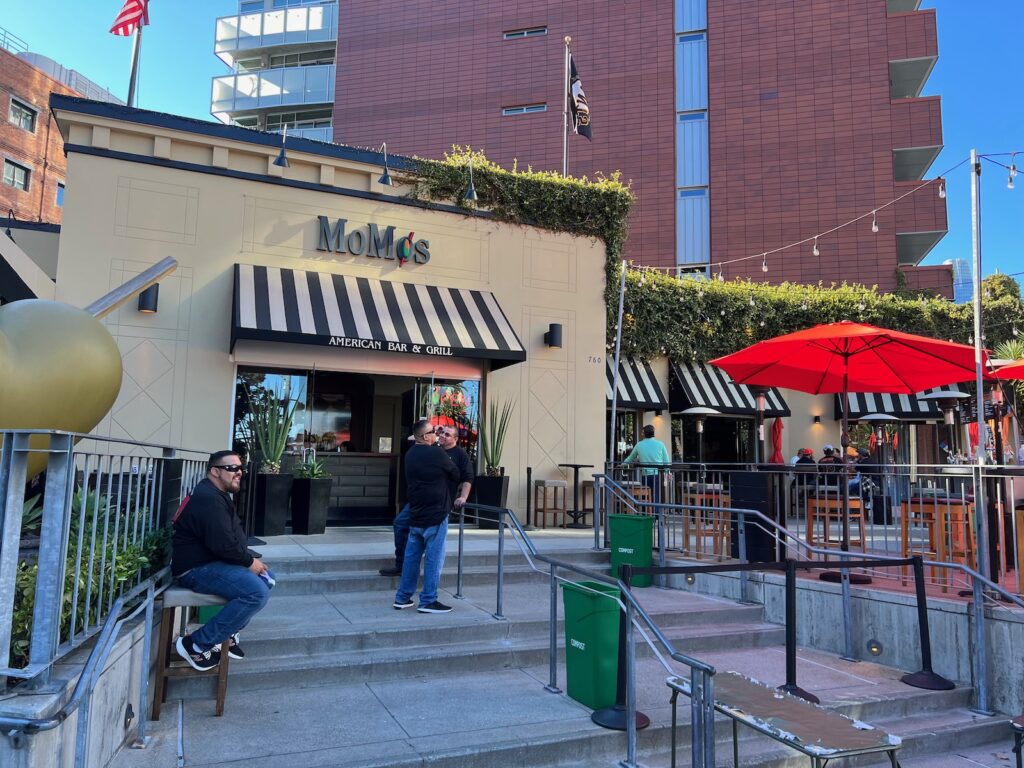
There are plenty of candidates here – the New Belgium Brewing Taproom and 21st Amendment are classic picks – but I’m going with MoMo’s right across from the left field entrance on King and 2nd, mostly for its scenic outdoor patio. The front patio is a hot spot for imbibing beer and cocktails before and after the game.
Best Seats: Lexus Dugout Club

Oracle Park’s best seats are the 3 to 4 rows of fully-padded black seats behind home plate. They include access to the Lexus Lounge serving complimentary non-alcoholic drinks, ballpark snacks, and two buffet stations. Most of the seats are situated below field level, so this isn’t my ideal perch for watching a game, but it’s worth trying once. Most notable are the TVs broadcasting the game right in front of you. There’s nothing cooler than watching a pitch in real time then seeing it replayed on a 6 second delay. You can call the umpire out on a missed strike call with certainty seconds after it happened!
Favorite Seats: View Reserve (upper deck), section 315 behind home plate
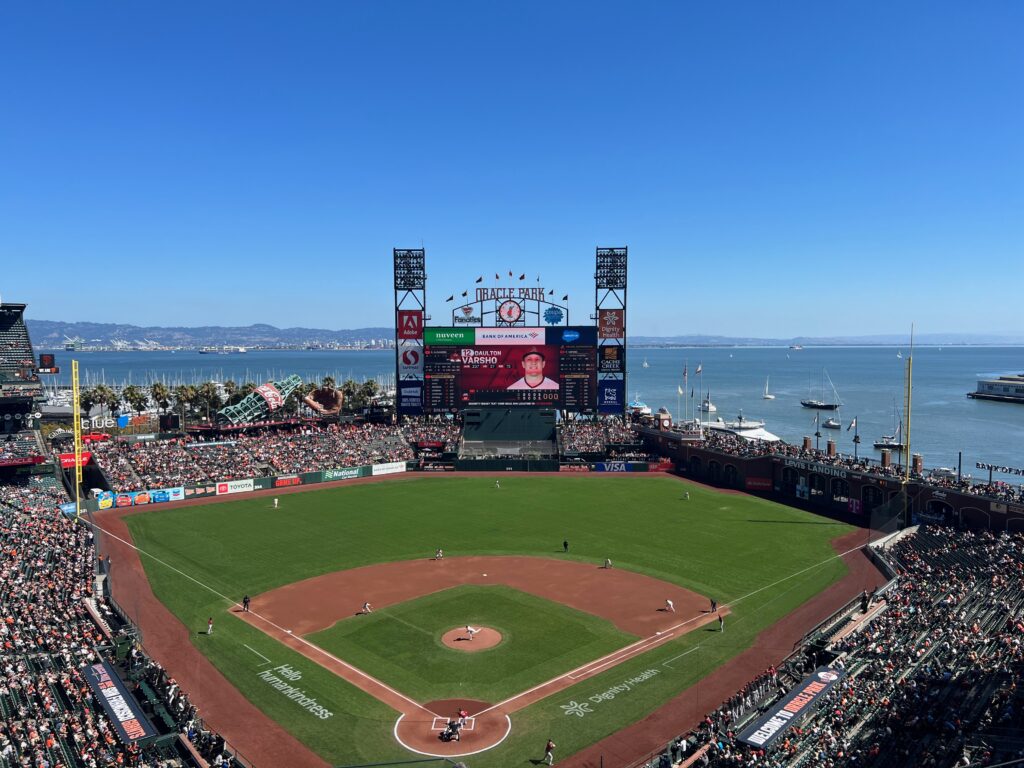
That’s right, Oracle Park’s best seats are the nosebleeds, where you get a ballgame and a poet’s view for $20! There is some debate on where to sit in the upper deck. Seats down the third base line offer views of McCovey Cove, but most of the water is actually beyond right center and left field. Seats down the first base line offer views of the Bay Bridge, but you don’t get McCovey Cove. Sitting behind home plate around Section 315 hits the sweet spot showcasing the whole picture. Independent of the view, I also generally prefer to be elevated anyway.
Signature Food: Crazy Crabz Sandwich, but you can’t go wrong with almost anything here
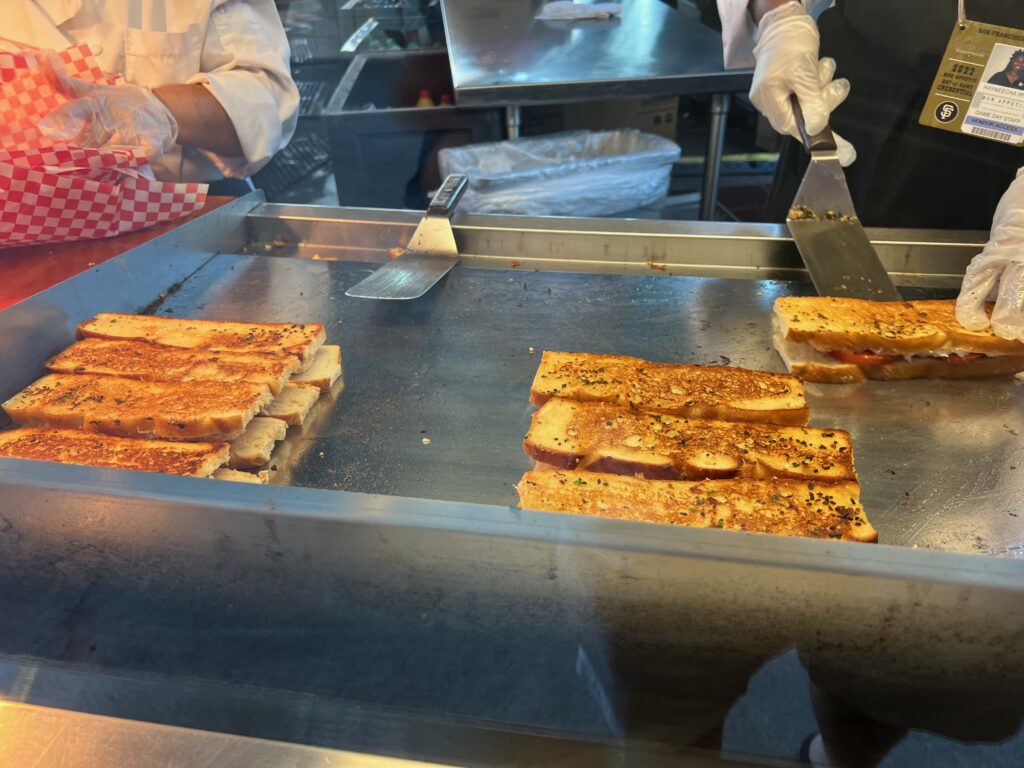
There are plenty of candidates here, but Oracle Park’s Crazy Crab’z Sandwich is my favorite food item in MLB. Dungeness crab and tomato on buttered and grilled sourdough bread is positively decadent.
Best In-Park Pregame Spot: Public House
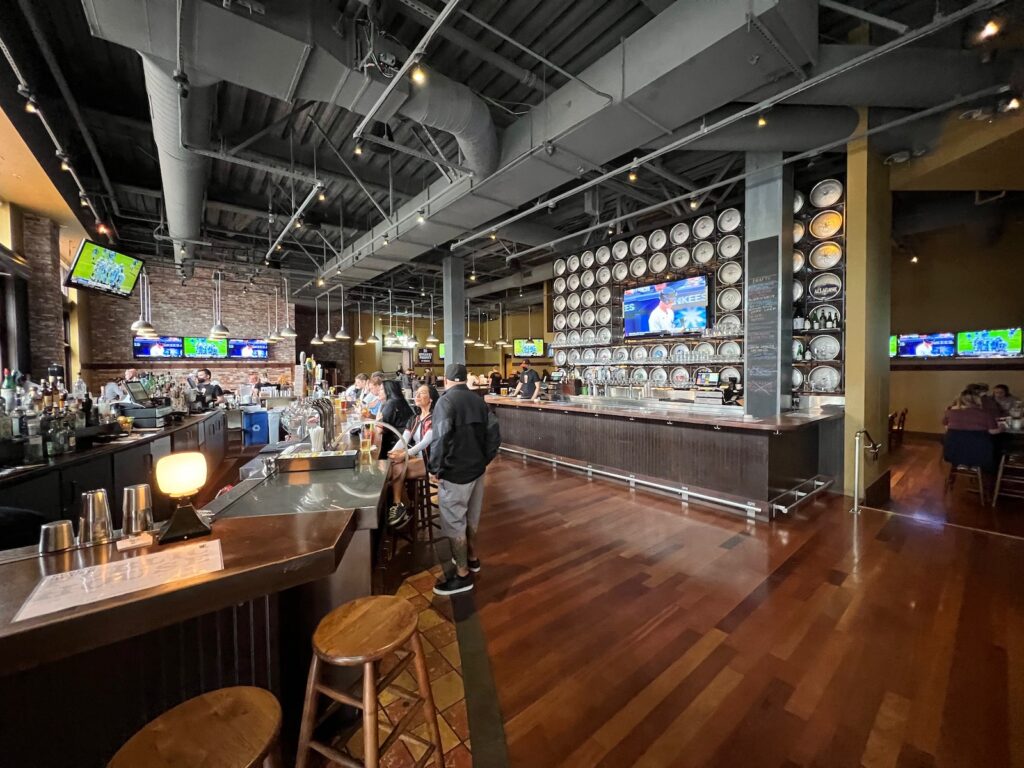
Oracle Park generally lacks the pregame social spaces of its contemporaries – again due to site constraints – so there’s no perfect pick here. The Garden is a good candidate, but it can get crowded and is more of a neat concept than a destination. So, it’s got to be Public House, Oracle Park’s only full-service restaurant and bar open to all fans. Full service table seating is an option, but I recommend you belly up at the bar and enjoy the house’s light bites and exemplary craft beer for quicker service.
Pro Tips
COMING BEFORE OPENING DAY 2023
Bet You Didn't Know
COMING BEFORE OPENING DAY 2023